 By Pepper Parr By Pepper Parr
BURLINGTON, ON July 18, 2012 Arnold Koopman has a problem. He is organizing a visit of a group of dignitaries that will include the Mayor of Apeldoorn, Burlington sister in Holland, to take part in the official opening of a park that he understood was to be named the Apeldoorn Park.
The name of the park that is to be officially opened is currently the Elgin Park. No one knows why the park, that is to undergo a major upgrade, was called Elgin – probably because it is on Elgin Street.
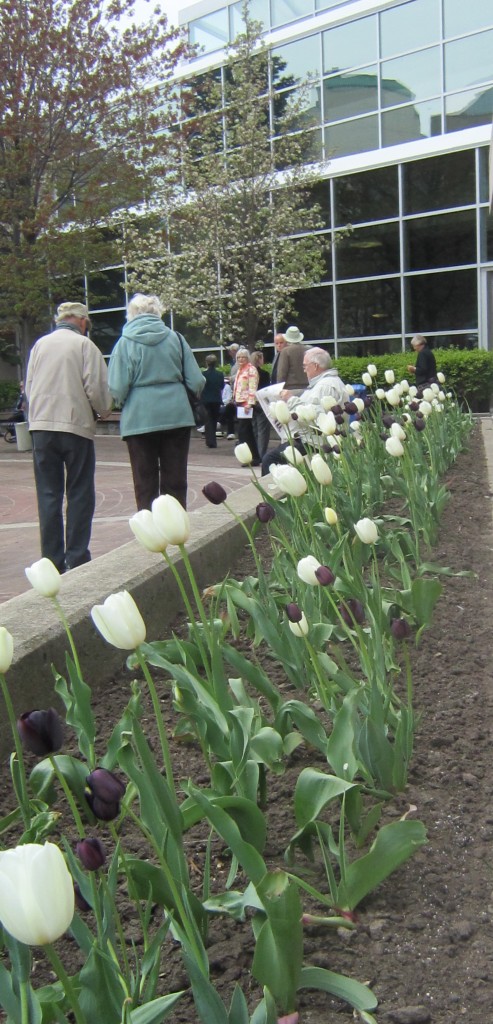 Tulips, Hollands gift to Canada, were planted at Civic Square last May. The Dutch would like to see a park commemorating the sacrifice Canadians made liberating Holland. An opportunity to do just that got missed last week. The Dutch should hold out for something bigger. If what we heard at a city council meeting was correct – there are no plans to change the name. Koopman doesn’t want to invite all those people from Holland in the fall of 2013 to stand there watching the flag of Apeldoorn be raised over the Elgin Park which will have what the city is calling an “Apeldoorn feature”.
This has the potential to be somewhat embarrassing but that’s where things stood at the last city council meeting and that’s where they will stay for at least the next six weeks.
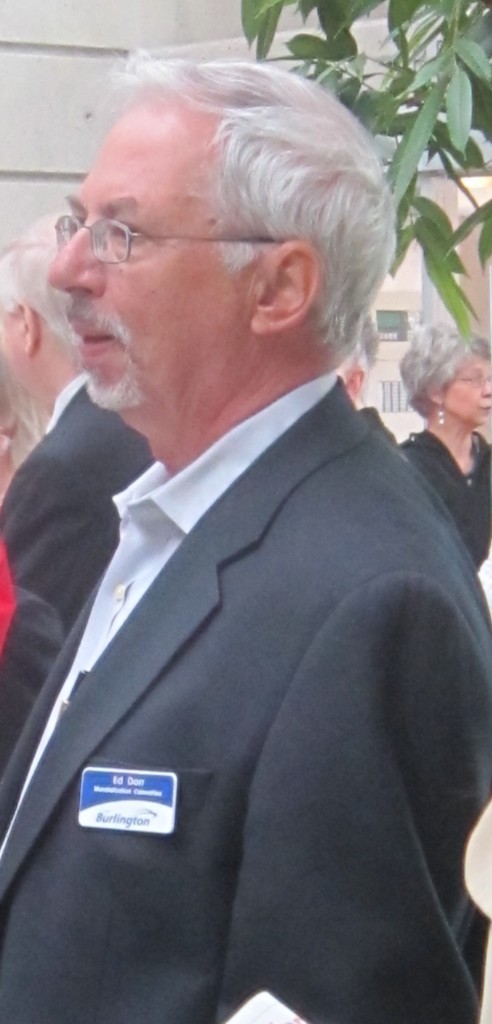 Ed Dorr has been a leading part of the Dutch community’s effort to have a park named after our twin city in Holland. He’s not there yet – but don’t count these people out. Apeldoorn and Burlington were twinned in May of 2005. The work on twinning the two cities began in 2003 – October 16, 2013 will be the tenth anniversary of the start of the talks. May 2015 will be the tenth anniversary of the agreement. The Dutch community in Burlington might well tell the city to let the Park they are re-developing remain as Elgin while they find a park that is worthy of the significance of the relationship between Holland and Canada.
The kerfuffle came about when the city found it had to replace the Roads and Parks Maintenance structure that is to the east of the very small parkette that is south of St. Luke’s Anglican church.
At the time the city decided that if they were replacing the building this was a good time to upgrade the park as well. Then why not use this park upgrade as the opportunity to create an Apeldoorn Park? Good question and so the city began to work up plans to remake the park, get the new maintenance building in place and do our part of the understanding that existed between Apeldoorn and Burlington for each city to have a park dedicated to the other.
When all this was being discussed at city council Ward 2 Councillor Marianne Meed Ward was against the project – she called it one of those “nice to have” projects we couldn’t afford. But Meed Ward saw which way the wind was blowing and didn’t see any point in fighting this one – so she became an active advocate for the park and was knee deep in the planning.
But there was an appetite for the park to have at least an “Apeldoorn feature” so the plan went forward – but no one ever did anything about the name.
It was a bit of a shock to the Dutch community. They were fully expecting a nice Park that would be called the Apeldoorn Park. They weren’t getting much of a Park to begin with – it’s almost a sliver of a thing.
Arnold Koopman left city hall wondering what his adopted city was doing to his people.
The Dutch are a persistent people – city Council has not heard the last of this argument.
There was one of those opportunities to cement a relationship with an important part of the community – but we blew that one.
The discussion went back and forth and really didn’t go anywhere. Mayor Goldring then asked Koopman if he would be happy with calling it the Apeldoorn Park on Elgin. Koopman grabbed that one, but Goldring failed to turn the comment into a motion – and so it’s Elgin Park until somebody does something about a name change.
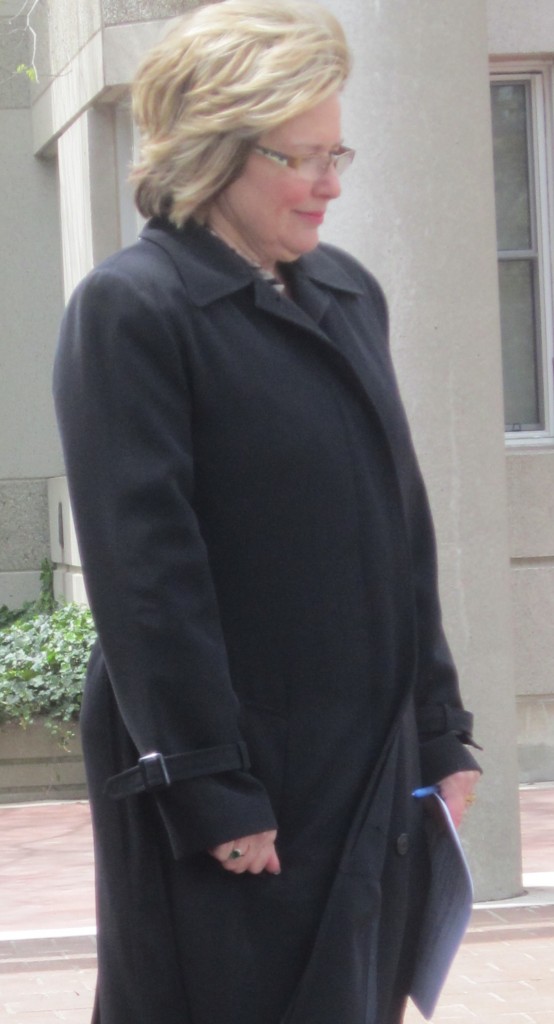 Councillor Blair Lancaster at the Mundialization ceremony at city hall last May – there was a chill in the air and there may be a bit of a chill from the Dutch community around the delay in naming a park for our twin city in Holland. It would have been nice to see Councillor Lancaster fight a little harder for the Dutch community. She is Council’s representative on the Mundialization committee that handles the relationship we have with Itabachi in Japan and Apeldoorn in Holland.
I think the Dutch should tell the city to keep their tiny park and advocate for something that reflects the contribution the Dutch have made to both Burlington and the whole of Canada.
The city of Apeldoorn has put back their plans to build a park they are going to call the Burlington Park. Economic conditions in Europe are such that spending is being pulled in everywhere – so we have a couple of years to come up with something that reflects the dignity the relationship we have with Apeldoorn deserves.

 By Staff By Staff
BURLINGTON, ON July 18, 2012 The Halton Region Health Department monitors the water quality at public beaches throughout Halton. Beach water monitoring on July 17 revealed the following beaches are safe for swimming:
Safe for swimming:
Burlington – Beachway Park
Halton Hills – Prospect Park Old Beach
Milton – Kelso Conservation Area
Oakville – Coronation Park East, Bronte Park Beach
The following beaches are unsafe for swimming:
Oakville – Coronation Park West

 By Pepper Parr By Pepper Parr
BURLINGTON, ON July 18, 2012 With the weather we have been having – talk of umbrellas will at least raise an eyebrow. There is an opportunity to raise those eyebrows at the Burlington Art Centre July 22, 2-3 pm when an exhibit of porcelain umbrellas by Ann Mortimer will be on display. The event is free.
 Ann Mortimer, who traditionally works on canvas with an admired ability to bring out the translucence of her object, has done a collection of 19 porcelain umbrellas that will be part of the In Series events at the Art Gallery. The work was produced in China under the direction of the artist. Ann Mortimer works in watercolour and is interested in the translucency of that medium. In her painting she aims to achieve an illusion of depth through the portrayal of light. You get to arrive at a different understanding of transparency when you view the umbrellas. Worth the time to take this one in.
Mortimer is a member of the Society of Floral Painters, and while she has specialized in flowers, combining a looseness of approach with a respect for botanical accuracy, she has ventured beyond canvas and into other mediums.
Curator Jonathan Smith will lead a tour of the exhibition, which includes the umbrellas and her perspective plates, bird-fish form and sculptural cups series.
The event is part of the In Series Exhibition at the Art Gallery – in the Lee-Chin Family Gallery.
Mortimer is a graduate trained teacher, and also paints a variety of other subjects in watercolour from landscapes to town scenes to figures. She enjoys sharing her techniques and skills with members of art societies at workshops and at the art classes where she regularly teaches.

 By Pepper Parr By Pepper Parr
BURLINGTON, ON July 17, 2012 Everyone thought it was going to be bigger and better than the Car Free Sunday on Appleby Line back in June but the crowd, if that is what you can call it, on Brant Street and Locust Streets for the second Car Free Sunday was not as large – something was missing.
 Interest group and services tents set up on Brant north of Caroline drew traffic – it was much quieter south of Caroline. Was it too hot; were people away at their cottages, kids off to camp? There was no reason to walk over to Brant Street – other than to be able to walk about with no traffic.
 Bus service was rerouted an cars kept off the street for most of the afternoon. Should it be an annual event? There was no focus to the event – but then there was no focus to the Appleby Line event and it had better participation than last Sunday’s event on Brant Street.
There was live music at the Civic Square but it drew very poor audiences. There was a Country and Western Music event at Spencer Smith Park and some of its traffic made its way up Brant – but there just wasn’t any sense that there was something going on.
The organizers did arrange for various interests groups to have tents on Brant north of Caroline – and they were busy and gave that part of the street the sense that there was something going on.
 There are retailers that get it – and they are the one’s that succeed. The shopping bag that lady is carrying isn’t empty. The folks that run Joelle’s understand retail. There were far too many stores closed. Far too many of the Brant Street merchants were not open – not a good sign. The Downtown Business association needs to get a bit of a burr under the saddles of some of its members. Those that were open did continuous business.
This was the first year the event took place. It’s worth doing the same thing next year, but there clearly has to be some brain storming if there are ever going to be people out on the street for large parts of a day.
Those who were lined up in their cars at Brant and Caroline to get through the intersection didn’t think very much of the idea of people taking over the streets of the city – even if it was only for a couple of hours.
There seemed to be more police presence than was necessary – lots of overtime booked by the HRPS.
 The pavement didn’t seem to be a problem. Get a dozen kids and a soccer ball plus two nets and you’ve got a game. It was pleasant to watch – some benches would have kept people around longer. The Burlington Teen Tour Band was out – they always draw a crowd but the idea was to have people out on the street for a large part of the 2pm to 7pm time frame. The barriers were taken up on Locust close to 6 pm and Brant was wide open to vehicles at 7 pm
During Sound of Music there were different attractions on the street that drew people and kept them around for a while. There were precious few places to get out of the sun and nowhere to sit and have a drink.
There were nets for kids to play soccer at the John and Brant intersection but there was no seating for anyone who wanted to watch the kids play.
 Brian Dean, top toff at the Downtown Business Association was out drumming up business for those of his members that took part in the Red Bag Sale. Too many of his members let the community down last Sunday. Keeping the doors closed while the city works at getting people out on the street isn’t the way the game is played.  There is a soccer player in there somewhere It was suggested that a focus was needed and there are a number of opportunities to bring in close to cost free events that would attract people and keep them around for a while. The antique car club people will show off their vehicles any chance they get. Inviting them to the city and asking if the owners of the cars would drive up along one of the rural roads with a guest passenger in their car – and then choose the guests from raffle ticket winners would certainly draw attention and participation.
A chance to sit in an MG or a Corvette with the top down would keep me hanging around hoping I got a chance for a ride. It would beat being on one of those nasty little ponies that were walking around the cenotaph at the side of city hall.
It is going to take some imagination to make this an event that people want to participate in and one that justifies closing down street for a period of time.
Good effort, they got the idea right now to add some ginger and make it more fun because there wasn’t much fun on Brant Street last Sunday afternoon.
There are a bunch of volunteers – more than 25 of them, that deserve more than the car free Sunday T-shirt they got. There were also half a dozen staff members who gave up half a nice day to make the event happen.

 By Pepper Parr By Pepper Parr
BURLINGTON, ON July 18, 2012 This is going to get interesting.
The Waterfront Advisory Committee is now officially dead. The funeral will take place at the end of the year – between now and then the committee will meet to clean up the odds and ends. It will not be a joyous occasion. The chair Nicholas Leblovic said he was blind-sided by the decision to bring an end to the life of the advisory committee, which is a little like someone putting their hands over their eyes and saying they cannot see. But the deed is done.
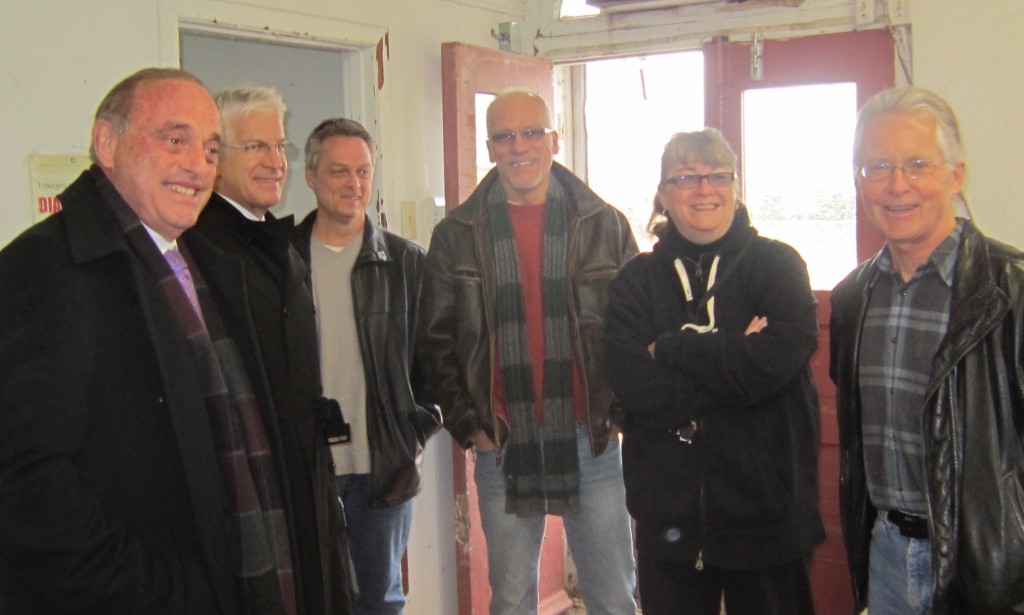 Waterfront Advisory committee in happier days. City council voted to shut the committee down at the end of December. Chair Leblovic, on the left, is thought to have been an ineffective leader that wasn’t producing the results the city had hoped for. While no one on city council would really say what the issue was that brought about the demise of the committee, Scott Stewart, General Manager Community Services put the problem in perspective when he said he voted against the committee with his feet when he stopped attending meetings. The committee was just not an effective group of people , basically because it was poorly led. While the chair gets the big end of the responsibility stick the other members of the committee have to share that responsibility – they re-elected Leblovic as chair.
What we didn’t know was that the Mayor was deeply involved in the committee member selection – and he wasn’t Mayor at the time. It is an experience that is behind us – and we can move on. The question is – move on to what? The waterfront isn’t going to go away and the problems plus the opportunities related to the waterfront are still there.
 Getting the Pump House on the Beachway on the agenda as a possible location for an upscale coffee shop wine bar was one of the successes of the Waterfront Advisory committee. It was a struggle for the committee members to get the idea past their chair. In her remarks when the issue was voted on – Meed Ward asked for a recorded vote and was the only one opposed to the ending of the advisory committee, said “City wide organized resident input is needed on a broad range of waterfront issues in Burlington. Our waterfront is one of the city’s features most valued by residents. But we’re losing a key source of resident input by the city council’s decision tonight to end the Waterfront Advisory Committee.” She went on to say: “The committee had provided a comprehensive list of recommendations on a range of waterfront issues that are now at risk of gathering dust sitting on a shelf. I’m committed to continuing to get residents input to ensure that the city and regional governments take steps to ensure public access to our waterfront.”
She made it clear to her colleagues that while the Advisory group may be dead, she didn’t see the issue or the people who were involved in waterfront issues as something that was just going to go away and she let her colleagues know that she would have the group “working out of her office”.
The evening that Council committee voted to sunset the advisory committee Mayor Goldring said he would “round up” a group of people and make them the ‘Mayor’s Advisory Committee on the Waterfront. So, we may have two committees giving members of Council advice on the waterfront.
What we are seeing here is a claiming of political turf. Meed Ward has grabbed the waterfront advisory aspect as hers. She sat on the committee and voted not to shut it down. Her fellow Councillors disagreed with her. Meed Ward will bring the committee “in house” as it were and bringing their views forward whenever she chooses.
A strong Mayor would have a meeting with Meed Ward and explain the role a Mayor plays in the municipal world and that if there is going to be an “advisory committee” it will be created by Council or created by the Mayor.
The vote to disband was taken at the last Council meeting until late in August; they are all off for the summer. Let’s see where this goes in the fall. It could get interesting.
[Facebook]

 By Pepper Parr By Pepper Parr
BURLINGTON, ON July 16, 2012 Parking tickets. Ugh! Many in Burlington think that if they own a car they have a God given right to park it exactly where they want to whenever they want to. Own a car and there are some downsides. When we used horses there were downsides as well – those little gifts they would leave on the streets – remember?
The city is going to take over the administration of the parking fines. If you don’t feel you were ticketed fairly you still get to go to the First Attendance room at city hall and argue for a reduction. The new set up – and you are going to like what the city is doing – will have that First Attendance office re-named and called a Screening Hearing.
If you’re unhappy with the results you can get a Court date – but you will not have to go to the Court house. You will be able to go to city hall and plead your case.
It gets better.
The city is looking into holding Night Courts.
 The city will run its own parking offence courts – might see a Night Court as part of the new Customer Service philosophy working its way through city hall. It gets better still. They are looking into holding these Parking fine sessions in different parts of the city. Now if they hold these Parking Offence Courts in different parts of the city and hold a Night Court as well – gosh you might leave the Court Room with a smile on your face.
More yet. Under the old system, if you wanted to dispute the parking ticket you were given a Court date and off you went – and you waited and waited and sometimes waited far longer than you think you should have.
The new system, courtesy of city hall, will send you a court date and give you a time frame to attend so you don’t have to spend a day waiting around.
THAT is customer service.
This new system applies to offences for which the fine is $100 or less. Thus if you park in a handicapped space you are still going to the real Court House – the fine for that infraction is $400.
 Free parking is not one of the options that comes with a car. You park – you pay. At this point the city gets somewhere between 100 and 200 situations where people demand a hearing. Any offence before July 3rd comes under the old system – which means dispute the ticket and you go to the Court House on Plains Road.
New provincial legislation allowed a municipality to choose to handle the administration of parking ticket offences and Bruce Zvaniga, Director of Transportation Services convinced the city to do things differently. On his LinkedIn page Zvaniga says he delivers innovative, sustainable transportation solutions that nurture livable communities. That doesn’t translate directly into making it easier to pay a parking ticket but this kind of innovation at city hall I welcome.

 By Pepper Parr By Pepper Parr
BURLINGTON, ON July 16, 2012 The Alton community took another step on the weekend to becoming a complete community. The Norton Park complex was officially opened and the public got to see just what the kids do on skate boards and mountain bikes. It is not something for those over fifty.
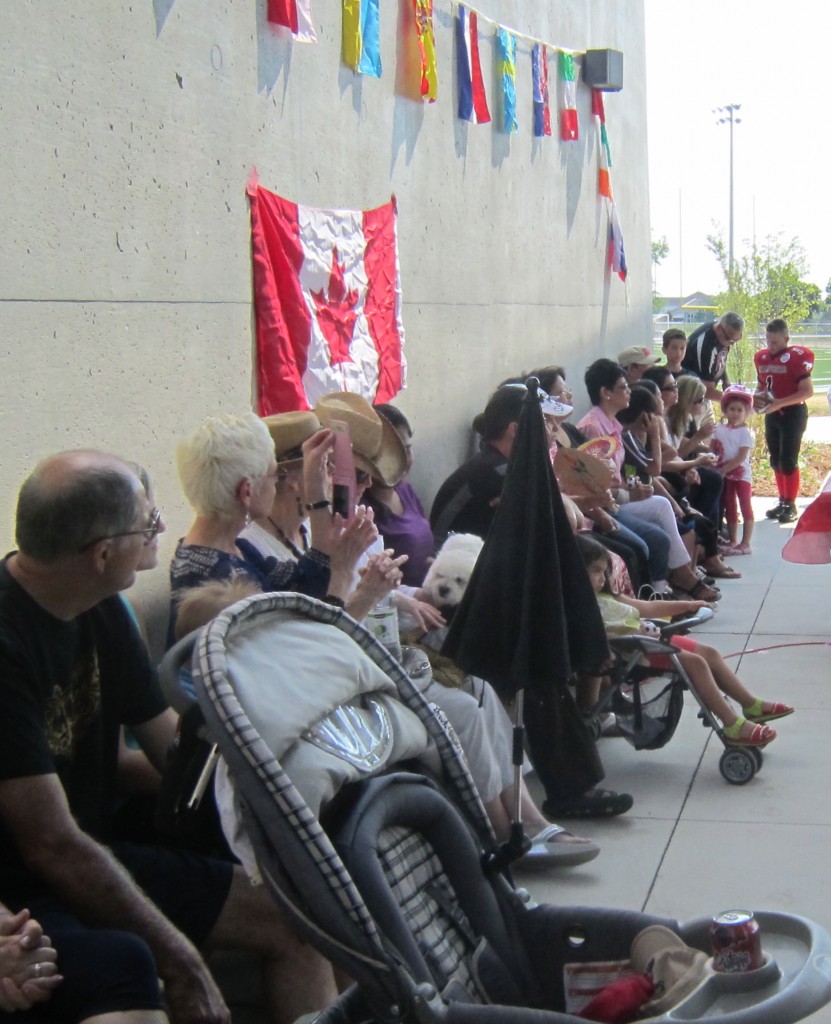 Residents of the community find a shady spot to sit in on the official opening ceremonies of the Norton Park. With the politicians done – the kids headed for the skate board section. There was a decent turn out. I’m never sure why the city holds these “official openings” – photo ops for sure, but is that it? The comments made don’t make any impact – we didn’t lean much other than the size of the facility and that it would tie in very nicely with the Alton Community Centre under construction across the street.
 Jennifer Johnson, Coordinator of Project Management for the city is the hands on person for the development of the Alton Community Centre across the street form the park. Tim Dobbie Drive, the road that runs from Dundas north into the community will get a softening with trees planted and humps – that isn’t a speed bump, but it will slow traffic. The idea is to create a setting where people are able to easily walk back and forth between the two locations.
 A helmeted youth listens patiently as Ward Councillor Blair Lancaster talks about the Norton Park and what it will mean to the community. She fortunately didn’t talk for very long. The skate board park on one side and the community centre that will consist of a school, a sports complex and a library on the other side has the potential to become a focus at the top of the suburban part of the city. Community building is more art than science but if all the ingredients are in place there is the potential to create something distinctly different than what Burlington’s suburban feel has been in the past.
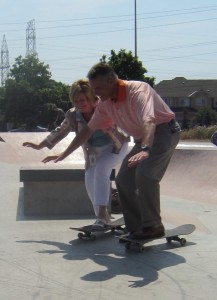 Ward Councillor Blair Lancaster and Mayor Rick Goldring put their political reputations on the line and stand on skate boards. Is there one foot on the ground there? The skate board part of the Norton Park is superb and there are all kinds of soccer fields in place. At some point they might add some tennis courts and maybe even a community garden. But these things take time. Give the area another five to seven years and the shade trees in place now will have matured and it will be a very pleasant place to spend time.
The library and the sports complex have wonderful potential. The sports part has a gymnasium layout that is flexible with very high ceilings. The long term thinking was to create a location where provincial level sports events could be held.
The high school will create an identity of its own, one that reflects the community and at the same time takes on the competitive nature of inter-high school rivalry.
One thing that was missing from the official opening event, and that was someone from the Norton family after whom the park was named. That family started a ‘bus’ system in 1936 and used a seven-passenger Pierce Arrow Limousine to take a group of kids to school. Norton recognized that every child, regardless of circumstances, needed and deserved an education and without his transportation, many students in the rural communities in north Burlington would not have been able to attend school. Over the next several decades, the Norton bus business grew into a fleet of 500 buses, transporting 15,000 students each day.
The company exists today as a charter bus service.
The present day location of C. H. Norton Public School is located several hundred yards from Cecil Norton’s former home. The Norton Community Centre is named for Cecil Norton who lived in the Headon Forest area.

 By Pepper Parr By Pepper Parr
BURLINGTON, ON July 19, 2012 Here’s one the environmentalists and community garden advocates might want to tuck away until city budget time. (Note that with Our Burlington you can find any story simply by typing what you are looking for into the search box on the HOME page.)
Hamilton set aside funds for a community garden coordinator that has paid large dividends, and may have silenced councillors who were once adamant that no tax dollars be provided for the position. Just six months of bridge funding to the Hamilton Community Garden network now has resulted in 15 new gardens and substantial fundraising success.
Pause and think of which Burlington city council members would have been on the “not a dime” part of that request.
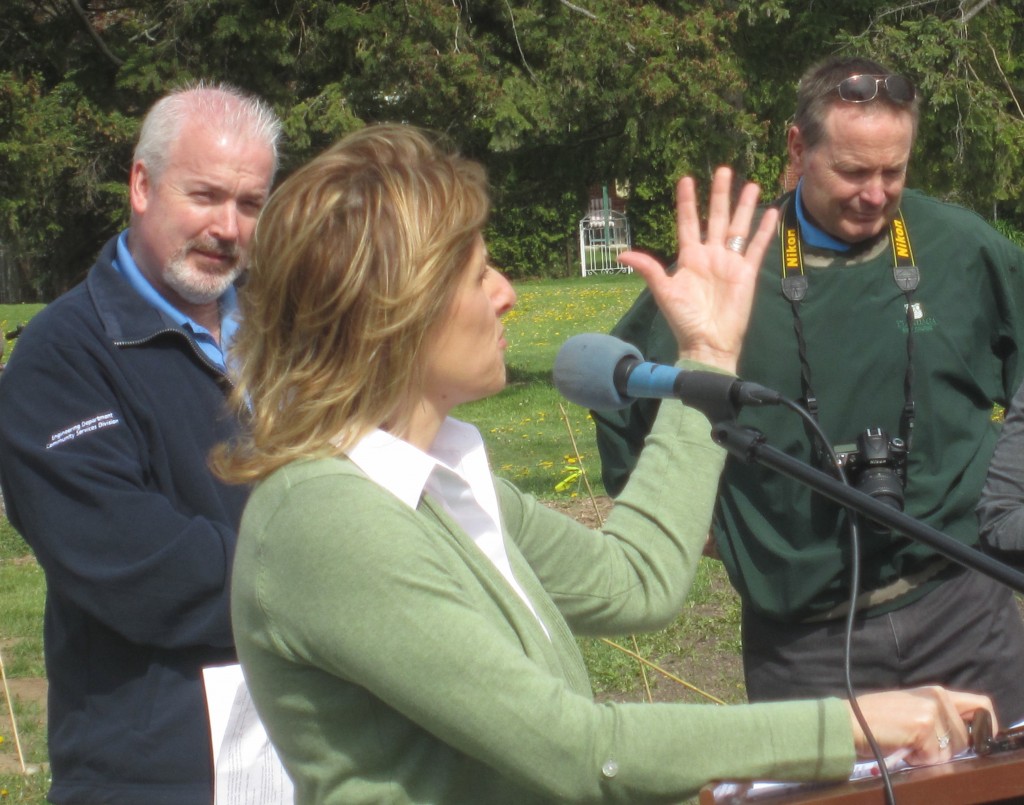 This is something Amy Schnurr just might choose to run with. Here she speaks at the opening of Burlington’s first community garden on public property. More to follow? City General Manager Scott Stewart is on the left with Rob Peachey on the right. At the end of last year, council approved $15,000 in bridge funding to keep a community garden coordinator employed while additional financial support was sought from other sources. Since February Clare Wagner has secured over $25,000 of in-kind donations and “at least $50,000 worth of funding” for local community gardens, while overseeing the establishment of 15 new gardens and the expansion of two existing ones.
The expansions have added 16,100 square feet of plots and are expected to produce 16,000 pounds of food per year. There are now 58 community gardens in all parts of the city including 1000 square feet in the Binbrook fair grounds, and a set of raised plots in Waterdown managed by Bethel Christian Reformed Church.
A report to the Hamilton city council noted “there are 150 people on a waiting list who wish to acquire space in current community gardens with 20 – 40 more inquiries from sites that do not keep a list of potential new gardeners.”
Lloyd Ferguson said he had “real trouble hiring a staff person” and suggested that organizing the gardens “should be part of the gardening experience” and not utilize taxpayers’ money.
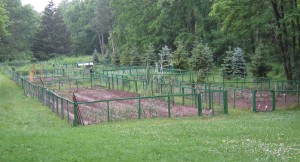 The Lutheran church in east Burlington has had a community garden for some time. It was a pattern for the community gardens now established in Central Park Former Hamilton councillor Dave Mitchell said he had complaints of weeds in a garden in his ward where there were “some nice homes”, and contended the gardens weren’t feasible. “You can’t have 50 different people in a small garden and expect them to get along together. I don’t think it will work very well.”
The community gardening network is managed by Green Venture. The coordinator can be reached at Clare.wagner@greenventure.ca.

 By Pepper Parr By Pepper Parr
BURLINGTON, ON July 13, 2012 Project Update # 16 and comments the Mayor made at the Wednesday Community Services committee meeting aren’t as aligned as things are going to have to be if THE pier is to open as planned in 2013.
General Manager Scott Stewart in his 16th report to Council committee on the pier said: Total completion remains as reported April 2013, with deficiency close out and occupancy by June of 2013.
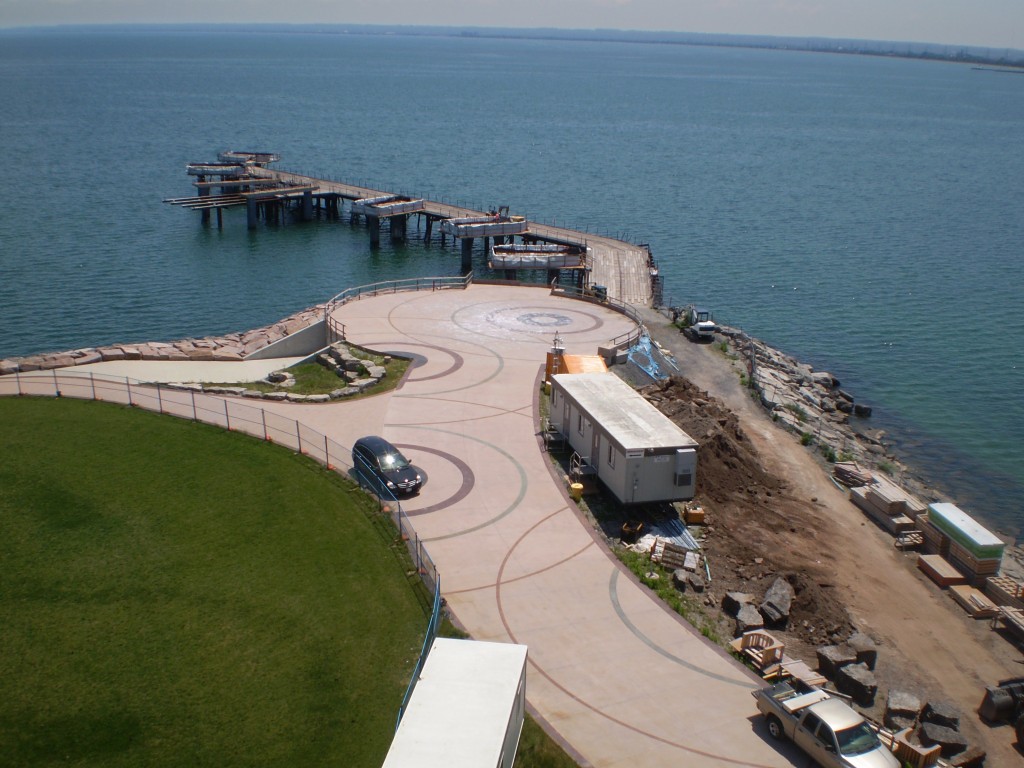 It is a truly attractive pier which will have cost the citizens a fortune but will open in 2013. Exactly when depends a lot on the kind of winter we have. The Mayor, for the first time, began to hedge his bet and said the important thing was to have the pier done right – which now means without the wind turbine that was to be an “iconic” element of the pier.
“If we don’t open for the Sound of Music in 2013, then we can open on Canada Day. And if not then, well during Rib Fest – maybe even Thanksgiving. The thing we need to focus on is getting it right and doing it properly”, said the Mayor. Those of us at the media table could not see if he had his fingers crossed as he spoke.
Councillor Meed Ward has been around this track before shot a hard look at General manager Scott Stewart and asked: “Is there any reason for delay that is not in this report?” You know everything I know” replied Stewart.
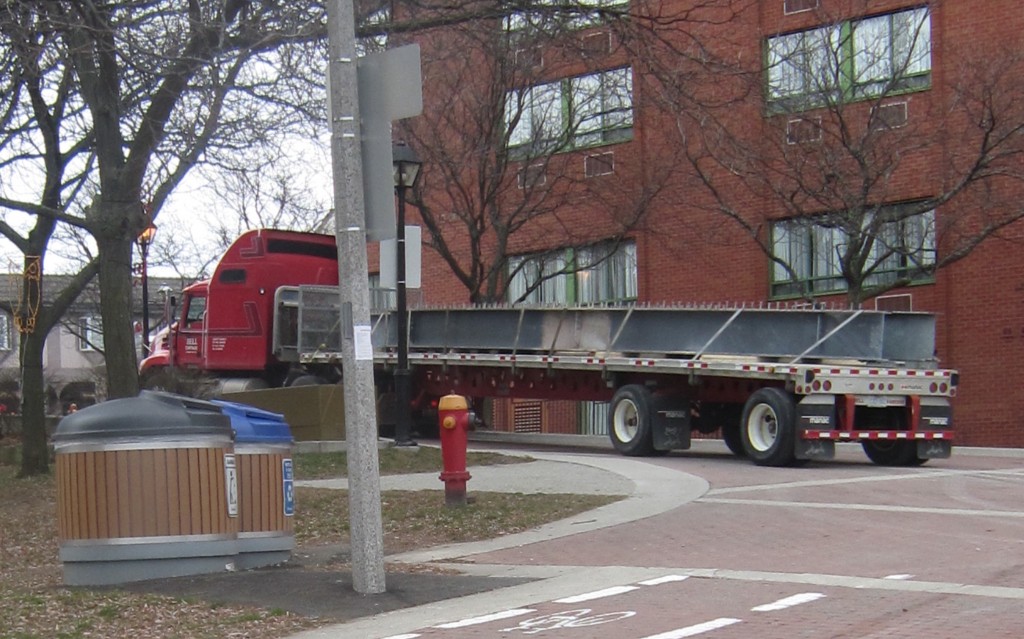 These beams didn’t meet the specifications called for in the original contract for the pier and had to be taken out and put in storage while lawyers argue who was right and who was wrong. New beams that have passed more tests than an army recruit will arrive later in the month. Then the sound of jackhammers will fill the air. Quality assurance and quality control is being used throughout every step of the way. “We test when the steel arrives, we test during fabrication and we test when it comes out of the processes.”, said Stewart.
Councillor Dennison wanted to know if there were any changes in the pier? “absolutely none” said Stewart, which is not quite true. The win turbine isn’t in place and isn’t going to be. There are structural changes that came out of the re-tendering process when new plans had to be prepared.
The expectation is the first of the steel beams will arrive the week of July 23rd. During the week ahead the city will begin to mobilize equipment that is needed to offload the steel beams and to get them in place. That probably means cranes and other heavy lifting equipment. If there is a crane out there that is guaranteed not to fall over – Burlington has it on order.
This project is now a race to get to the point where concrete can be poured before temperatures dip to the point where concrete cannot be poured.
 Walkway to the “instant beach” that just sort of appeared on the west side of the pier site has been put in place. There are dozens of small jobs that can be done now while the city waits for the arrival of the steel beams that form the base of the pier deck onto which concrete will be poured. The focus now is on how much can be done now and how much can be done while the beams are being put in place. Large contractors now have software that allows them to juggle things the way a guy in a hard hat couldn’t. But the one thing no one can juggle is the weather and those who have worked on the water at this end of Lake Ontario will tell you that the lake changes late in September and with the wild temperature swings we have been experiencing all the software in the world isn’t going to help.
The tender fruit people in the Niagara region saw an early frost damage a lot of crop resulting in very few cherries on the market and peaches and pears getting close to harvest but not very much on the fruit trees. If you’re going to enjoy peaches this summer – you’re going to pay for them.
The project remains on budget. It’s just that this time it is a much bigger budget. Costs are being monitored in a detailed cost tracking log. The project has more minders than a Russian spy who has defected.
Thanksgiving eh? Better late than never – not everyone would agree with that statement.
While the contractors involved in the project watch the weather and move as quickly as they can, another group of people pore over documents as the legal people get ready for what the lawyers call “discovery”, which is when each side of the argument exchange documents and get ready to examine witnesses under oath. Director of Engineering Tom Eichenbaum will be a vital part of the city’s case, he is basically the only person left on staff who was heavily involved in the project. Eichenbaum will spend many days in a room with lawyers asking question after question and producing document after document. The city will want to maintain it did everything right and the contractors will want to use the documents to prove that the city made significant errors.
There are some who assume the city has a solid case and will win their claim for damages. There are many in the construction community who will tell you that the case is not all that solid.
And if Eichenbaum’s presentation at a city council committee meeting recently, where he took Council through a who did what and when during the wind turbine decision, is any example of the testimony he is going to give – we might be in more trouble than we were prepared for when we sued the contractors and designers of the pier.
We might also never know who has to pay what. Most people in the construction industry believe that once the discovery process is over the city will review what came out and might find themselves willing to accept an offer from the contractors. That offer to settle will have a gag order attached to it and we will never know who paid what to whom.

 By Pepper Parr By Pepper Parr
BURLINGTON, ON July 13, 2012 Burlington is going to pull out all the stop for this second car free Sunday. The first car free day was in the east end of the city where large parts of Appleby Line were closed to cars. Turnout was good – could have been more but it was far from a disaster.
Now that the city administration knows the public can be gotten out of the houses and onto the streets to have fun and mingle – this second effort in the downtown core will leave officials know if this kind of thing can be done more frequently.
There wasn’t all that much opportunity for the retail market to experience all that much of a boost on Appleby Line – but Brant Street has a much different commercial makeup. Merchants can take advantage of larger crowds and perhaps even see more in the way of traffic than they see on a good Saturday with cars on the street. It’s a gamble but something has to be done to get people out on the streets.
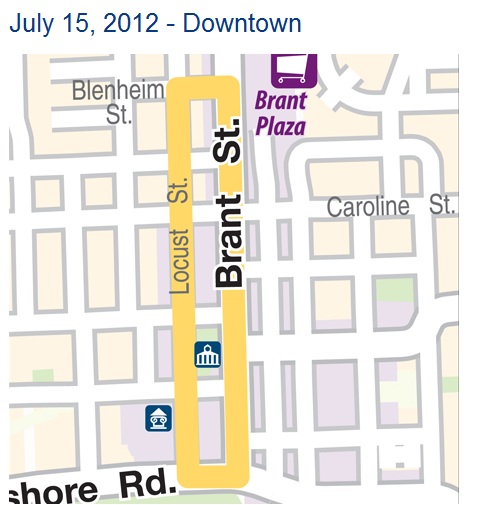 Streets that will be car free Sunday July 15th. Read the detail carefully. Full lane closure on Brant Street between Blenheim Street and Lakeshore Road.The north two lanes on Lakeshore Road between Brant Street and Locust Street will be closed and the northbound lane on Locust between Lakeshore Road and Blenheim Street will be closed.
The stretch of city streets that will be closed on Sunday between 2 and 7 pm will include: full lane closure on Brant Street between Blenheim Street and Lakeshore Road.
The north two lanes on Lakeshore Road between Brant Street and Locust Street will be closed and the northbound lane on Locust between Lakeshore Road and Blenheim Street will be closed.
The initiative came about when Councillors Dennison and Sharman took the idea to Council where the Mayor who is an environmental advocate bought into it and while Councillor Meed Ward didn’t buy into the idea at first she was big enough to admit that she hadn’t gotten it right the first time but knew a good thing when she saw one and dug out her blades and joined the parade.
The Downtown event will feature different groups with their tents out on the street one of which will be the Community Engagement Charter crowd – and they need help. This is a group that has the right idea but has not managed to attract nearly enough people to their cause. If things continue the way they are going this city might find itself with a Community Engagement Charter written by a group of less than 50 people.
The group will have a table and a tent at Caroline and Brant – drop in and hear what they have to say. They are talking about your city and how it can work better.
The Country & Blues BBQ Festival will be taking place in Spencer Smith Park
The Burlington Teen Tour Band will parade during the event.
There will be food and drink vendors out on the street, there will be a Marketplace and Pony rides.
There will be live music from Tori Sutherland, Harrison Kennedy, Michelle Titian, Mary Simon and the Hill Brothers.
One of the Mayors favourite city’s, Portland Oregon, has been doing things like this for years and our Mayor is convinced events like this can work and are good for the city. Let’s see if he is right. What matters most with this event is this – will is draw people from Aldershot and the communities north of the QEW hump? If it does, it will be a great success.
Getting people from all over the city, not just those who live in the core and can ride safely to the stretch of streets that will be closed.

 By Pepper Parr By Pepper Parr
BURLINGTON, ON July 13, 2012
The Halton Region Health Department monitors the water quality at public beaches throughout Halton.
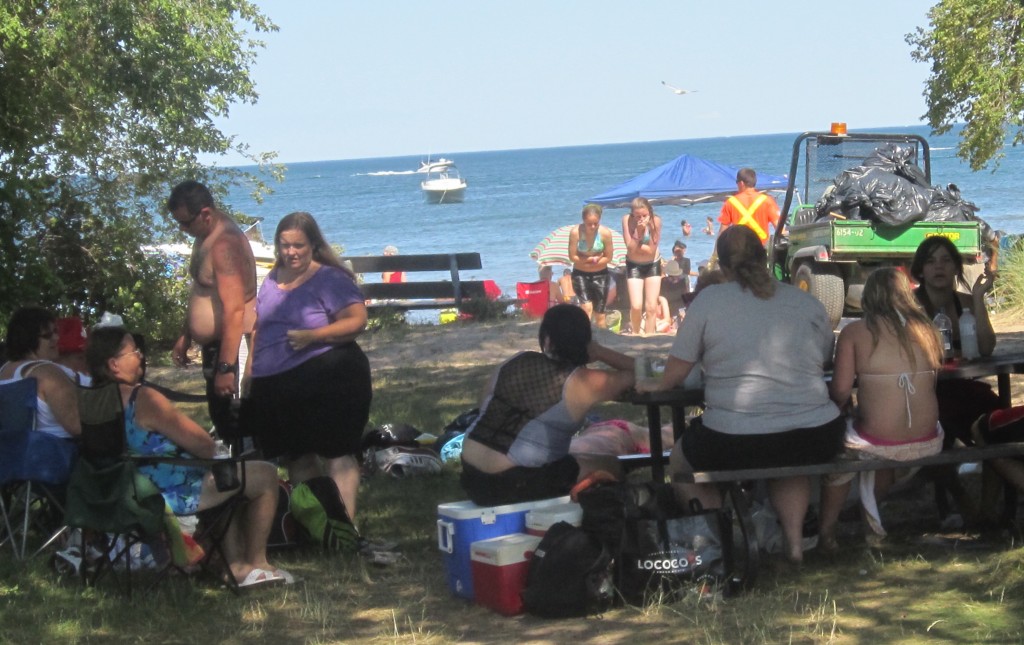 Hundreds of families used Beachway Park on Canada Day – they had no way of knowing if the water their children were swimming in was safe to use. That weekend the water to the left of an imaginary line was safe, the water to the right wasn’t. There was no signage telling the public about water conditions. Beach water monitoring on July 10 revealed the following beaches are safe for swimming:
Milton – Kelso Conservation Area
Halton Hills – Prospect Park Old Beach
Oakville – Coronation Park East
The following beaches are unsafe for swimming:
• Burlington – Beachway Park
• Oakville – Coronation Park West, Bronte Park Beach
Burlington Beachway Park North and Burlington Beachway Park South have been combined and will be reported as one beach: “Burlington Beachway Park”. Samples and monitoring will be done along the entire length of the beach and an average of all the bacteria samples will determine whether the beach is considered safe or unsafe.
Up until this change the Region had chosen an arbitrary line in the lake and called one part Beachway South and the other Beachway North.
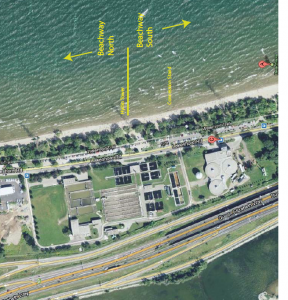 Up until very recently this imaginary boundary in the lake defined parts of the lake that were safe or unsafe for swimming. That boundary has been discarded. Now all the Region needs is signs along the Beachway Park to tell the public if the water is safe or unsafe. Some confusion was created over figuring out how the water on one side of a line could be safe while water on the other side the water wasn’t safe.
The Region solved that problem by removing the imaginary line and telling us that all the water is unsafe.
Now, all they have to do is post signs along the Beachway Park so those who don’t read Our Burlington, maybe don’t even know about us yet, can know if the water they swim in is safe.
On Canada Day there were hundreds of families in water the Region described as unsafe.
The Regional Municipality of Halton serves more than 500,000 residents in the City of Burlington, the Town of Halton Hills, the Town of Milton, and the Town of Oakville. Halton Region is committed to meeting the needs of its residents through the delivery of cost-effective, quality programs and services, including water and wastewater; Regional roads and planning; emergency medical services; waste management; public health; social assistance/Ontario Works; children’s and seniors’ services; social/non-profit housing; heritage programs; emergency management and economic development.
Effective signage, in more than one language would be an effective way to communicate public safety.

 By Pepper Parr By Pepper Parr
BURLINGTON, ON July 13, 2012 Burlington’s Seniors made it big time Thursday morning. Joe Lamb, a member of the Seniors’ Centre negotiating team that has been meeting with the city for some time to create a revised Memorandum of Agreement (MOU) that will keep everyone happy while the seniors enjoy using the centre and the city pays most of the bills.
Lamb asked the crowd of close to 150 people to vote for the MOU that had been approved by the Centre’s Board of Management (BOM)
It was hard not to vote for the agreement – which the members in the room did unanimously.
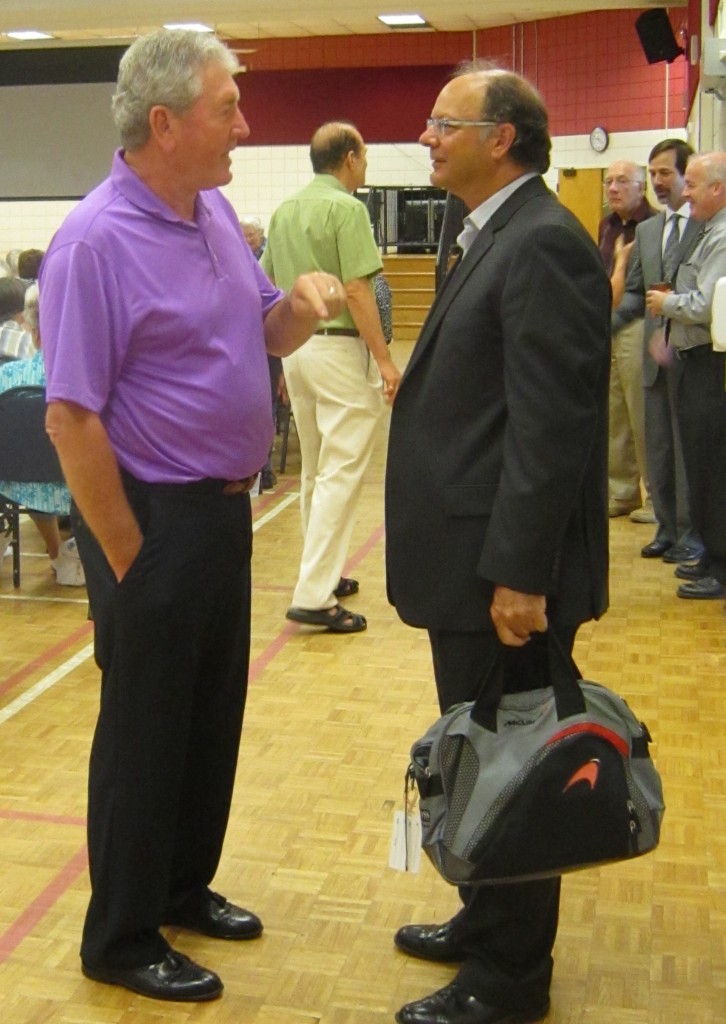 Lead negotiator for the seniors was Joe Lamb on the left talking to city manager Jeff Fielding on the right. The agreement they hammered out was approved unanimously by the seniors Centre membership. Lamb kind of liked being back in harness. On the far right are Parks and Recreation Director Chris Glenn and general manager Scott Stewart. They now have to make the agreement work once it is passed by city council. The city insisted that the Centre’s Board of Management incorporate, not something they were all that keen on doing – but the city slid $5000 across the table to help out and it took about a Nano second for the BOM to take up that offer. Lamb explained that “some of you felt that incorporation meant the BOM was going to start running the Centre in its entirety and the City was going to have very little to do with the centre. I want to assure you that nothing could be further from the truth. Your Board has no desire to venture down that road whatsoever.”
The city wanted to see the Centre with the appropriate liability insurance – city wanted that in place badly enough that they said they would pay that as well.
Things were looking really good for the Seniors and Lamb certainly proved his mettle as a negotiator. There really wasn’t anything he didn’t get.
The Centre runs a small kitchen which has been a significant point of contention with the city – when you can’t resolve a problem – put it off for a year and agree to continue to talk about it – which is just what Lamb and the city Manager Jeff Fielding agreed to do.
Sales at the Bistro, the small kitchen at the Seniors’ Centre, should have had HST applied – the Centre hadn’t been doing that for the past three years and the number crunchers came to the conclusion that the Centre owned the government close to $20,000 – not to worry the city is going to pick up half of that amount.
Clearly the people at city hall wanted an agreement in place with the seniors and were going to throw as much money as necessary to get the Seniors’ to vote for the Memorandum of Agreement agreed upon.
The Seniors are really feeling their oats. They’ve realized they have real political clout. When they don’t get what they want they pick up their phones and call their Council members – and when 3000 seniors make phone calls you know what happens to a Council member who now has to deal with these people. They call the administration and howl – fix this problem.
The seniors can tie up a phone line for 15 minutes – most probably has their Council members’ phone number on speed dial.
As Lamb got into the meat of the agreement he explained to the 150 people in the room that the arrangement with the city was going to be a “collaborative and cooperative partnership between the city, members, and the Board of Management”.
The revised MOU gives the seniors exclusive use of the space from 8 am to 5 pm, Monday to Friday. They can’t just be bumped out of a program because the city wants to use the space. There will be occasions when the space is used by others – elections is one of those occasions. Lamb explained that the revised MOU will set out what has been practice in the past but is now on paper and in writing. So when the seniors have exclusive use of the space is now clear.
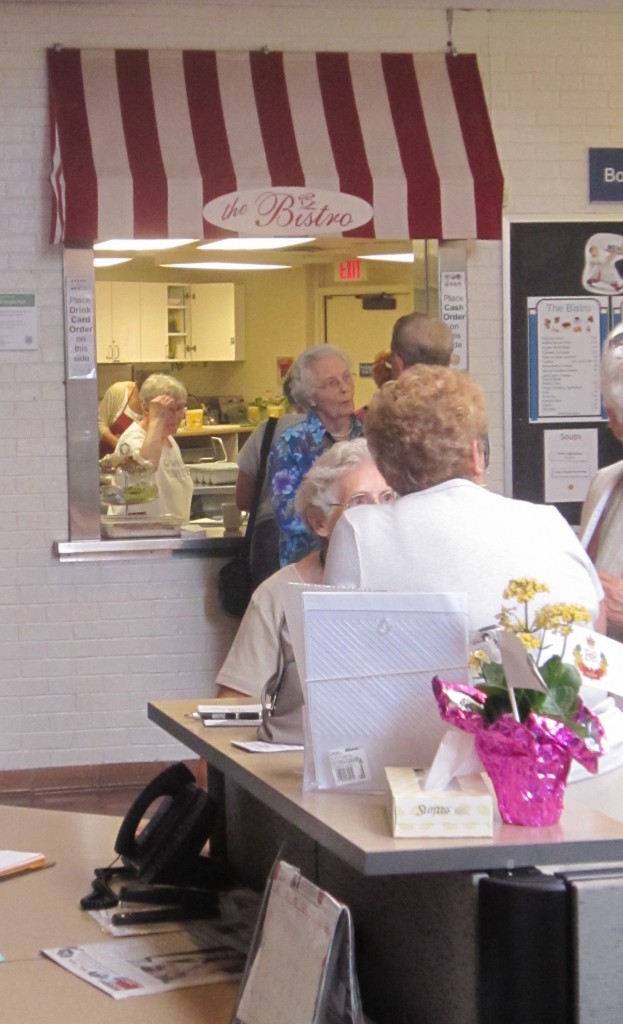 The Bistro, the heart of the Seniors’ Centre and the focal point for many of the administrative problems. The new agreement with the city didn’t resolve this problem but they have agreed to give it a year to come up with a solution that works for everyone. The biggest problem area has been the kitchen. In many ways it is the heart of the Centre. They call it the Bistro and is run jointly with the city. The one employee, Maria, is on the city payroll, mostly because the Centre doesn’t have anyone who can process a payroll and ensure all the proper deductions are made.
But with Maria on the city payroll – the city needs to ensure they have the required oversight and that was the problem – the seniors didn’t want the city getting involved in the running of the kitchen and the city didn’t want to be in the kitchen either. When there is any food handling involved the city out sources the work. The seniors began to have vision of a pair of Gold Arches appearing in the building. They had a neat little kitchen operation and they wanted to keep it that way. Fine said the city but if the employee is on our payroll there is some liability that lands on the city’s desk and if there was going to be liability – the city wanted control, or at least enough control to be able to manage the problems when they crop up.
You can begin to see how the two sides to this one were shaping up.
And that is where the working relationship between Lamb and Fielding, the city manager came into play. They agreed that an agreement was necessary but they didn’t have one – so they would agree to work together with the revised MOU for a year and during that time let experience and time get put to use to find something that works for everyone.
The reality of this is that the employee is on the city payroll in a building the city owns – that boils down to the city having the final word. That is something the seniors are going to have to accept. Fielding just has to find language that keeps the seniors happy. The seniors all recognise the phrase “a spoonful of sugar helps the medicine go down” and they have a year to figure out just how much sugar is going to be needed. The city doesn’t appear to have too many problems spending money on seniors.
Five thousand for incorporation, $9,000, give or take a couple of hundred for insurance – tasting pretty sweet at this point.
The BOM owns some of the equipment in the kitchen, the city owns the rest. BOM reimburses the City for Maria’s costs and any profit or loss for the kitchen goes to the BOM
The kitchen is rented out many times in the evening and weekends by the city. Both parties share keeping the place clean and for the most part the city is responsible for bigger maintenance and capital items. It is a unique arrangement which seems to work.
BOM doesn’t want to take over the operation of the kitchen; to do so would mean taking on the same contingent liability. The Board turns over quickly with only 2 year terms, and although have some kitchen knowledge there are no assurances that this will continue in the future.
Insurance is such a critical part of this joint venture the city will be arranging and paying for the insurances required by the BOM, which Lamb said was “very much appreciated” .
BOM and the city agreed to give it some time for the kitchen issue to be worked through and to use the positive tone of their discussions to get to a conclusion everyone can live with .
Because of the liability involved the city wants to ensure that during the next year the kitchen meets government standards, which means oversight. It’s a delicate dance – but both parties want to be out there on that dance floor, so they will work something out – unless the seniors get cantankerous and then they will lose everything.
Currently 10% of all rentals, program fees and membership fees go into a special Reserve fund to support capital improvements at the Centre. The fund has grown to about $222,000. The Board can access these funds for projects or emergencies with the permission of the Director of Parks and Recreation.
Communicating has consistently been the problem and along with it some sensitivity to the different roles each group plays. The city has responsibilities, the centre has people it wants to care for. The city runs programs, takes care of facilities and has different supervisors handling these things. The BOM people would like there to be one point person for them to deal with at city hall. The best Lamb could do on that was plant the seed and hope for the best.
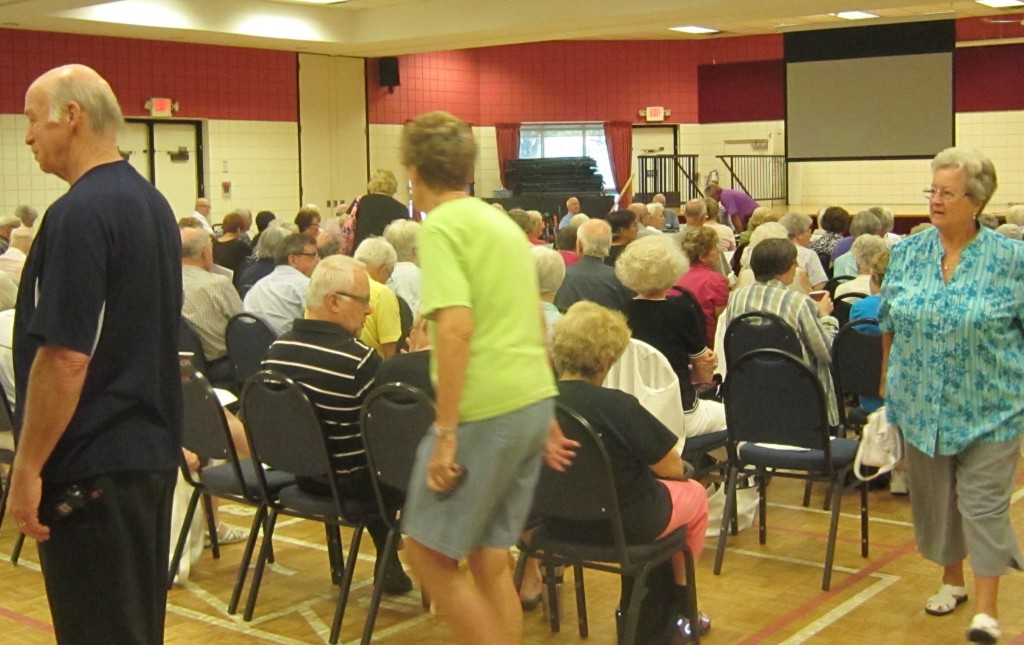 More than 150 members showed up to learn about the new agreement with the city and to vote for it unanimously. Quite a difference between this meeting and the 300 members who were angry at a February meeting. The MOU has provision for the city and BOM to me at least once a year to develop plans and get feedback and input from the members It is easy, said Lamb to blame the other party when problems crop up; we need to ensure that this type of divide never exists again.
Joe Lamb’s wife, Cathy, used to be the liaison between the city and the seniors’ Centre. She retired and the person put in as her replacement didn’t bring quite the same touch to the task. Things went downhill from there which brought forward the need to revise the working arrangement.
Having a document in place is one step – finding the right people who can and want to bring the needed level of professionalism and care to a task is something else. Burlington has one growth industry – seniors. The city already has the largest seniors population in the Region.
The city struggles with getting some commercial growth in the downtown core; it doesn’t have to struggle for the growth in the seniors population.
What it does have to do is find the kind of people at city hall who can work with seniors and then begin giving some thought to operations in different parts of the city. What is there for people between the QEW and Dundas other than programs run at different churches? Is Aldershot adequately served?
There is no strategy for serving the growing seniors population. Councillors Sharman and Dennison have held workshops with different seniors groups but we’ve not seen any initiatives come out of these meetings. Data has been gathered, opinions recorded – time now for some action. It is time for Burlington to come up with a strategy on how they are going to serve these people.
They seniors want taxes to be kept low and they want better service – those two don’t complement each other. While many seniors don’t want to use public transit, partly because we have a poor transit system, not one geared to their needs. The time however is going to come when many if not most of those seniors will not be able to drive. The city is going to have to find ways to allow them to get about the city and bicycles aren’t the answer.
The seniors won much of this last scuffle. But there is a bigger challenge looming out there and it has to be met.
Ultimately the city is responsible for the Centre and unless the newly incorporated BOM wants to indemnify the city, and the insurance for that would be stiff, this is a city operation with all the input the seniors want to make – as long as they are reasonable.
Times have changed and the seniors need to move along with the change.
Some things though just won’t change.
Before the meeting started the seniors were asked to stand and sing O’Canada, which they did with strong voices – and did a much better job than city council members do at council meetings.

 By Pepper Parr By Pepper Parr
BURLINGTON, ON July 12, 2012 This is one of those “local boy does good” stories – except that the story is about two brothers and one of their best friends who lived just up the street – still does. The three of them, along with a fourth person – a woman, are involved in the production of Harold Pinter’s major dramatic work play Betrayal, which involved just two men and a woman who all betrayed each other. The play itself is complex, but the Burlington group involved in the production of the Pinter play are not in the least complex.
They are an energetic serious bunch of young people who are either out of university or close to graduation and doing something they all want to do.
Mischa Aravena is the actor and producer, his brother Mel is the producer of the play. Friend Tom Hart is the assistant director while Jeanette Hicks is the set designer. Jeanette is a professional artists and has worked on a number of films, a Toronto Fringe show. She has exhibited her work at the Art Gallery of Ontario Gift Store.
The play is part of Hamilton’s Fringe Festival – with productions talking place July 21 at 9:45; July 22 at 6:15; July 23 at 9:30; July 25 at 6:30; July 26 at 6:00; July 28at 2:30 and July 29 at 6:00. Arrive on time – no entry no matter who you are, once the play has begin. All Betrayal shows are at the Citadel Studio Theatre in Hamilton. The Studio Theatre is built every year specifically for the Fringe event. The tickets are very modestly priced at $9 each. The Fringe is there to give young actors and set design people an opportunity to gain some experience and public exposure. A number of Fringe productions have gone on to New York and then into film production.
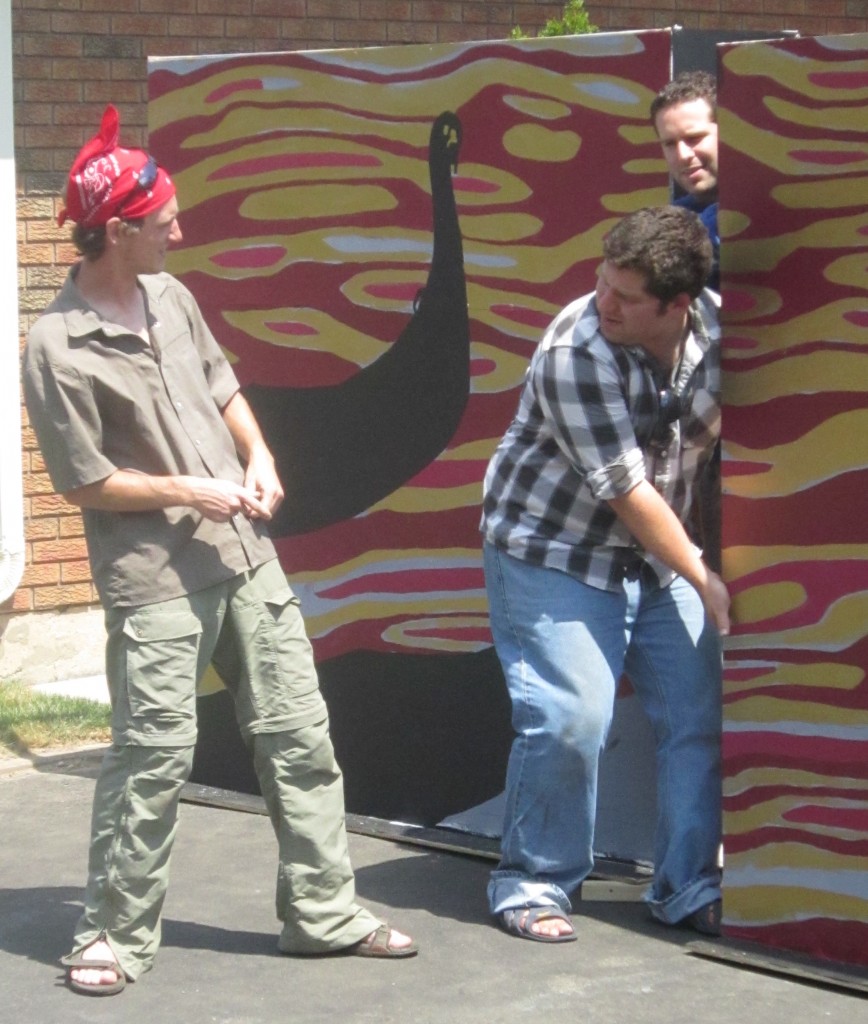 The Aravena brothers, Mel out front in the centre with Mischa peeking out at the top, with Tom Hart giving advice on where the set piece should be placed. The Aravena brothers tried to get into the Toronto Fringe Festival where the approach is to take all the entries that come in and draw names out of a hat. They didn’t make the draw, but they were well enough prepared to get their application into the Hamilton people, where they were selected on merit.
Now to get the lines learned, the feel of the way they want to do the play and the set painted and ready for placement on the stage.
Mischa is the more intense of the two brothers; he will play one of the three characters in the production. His brother Mel is the director and has basically worked with Mischa on most of what he has done on stage.
The play was inspired by Pinter’s clandestine extramarital affair with BBC Television presenter Joan Bakewell, which occurred for seven years, from 1962 to 1969,. The plot of Betrayal exposes different permutations of betrayal and kinds of betrayals occurring over a period of nine years, relating to a seven-year affair involving a married couple, Emma and Robert, and Robert’s “close friend” Jerry, who is also married, to a woman named Judith.
 Jeanette Hicks: set designer. That apron is worn when she paints, she doesn’t cook or feed the others. For five years Jerry and Emma carry on their affair without Robert’s knowledge, both cuckolding Robert and betraying Judith, until Emma, without telling Jerry she has done so, admits her infidelity to Robert (in effect, betraying Jerry), although she continues their affair. In 1977, four years after exposing the affair (in 1973) and two years after their subsequent break up (in 1975), Emma meets with Jerry to tell him that her marriage to Robert is over. She then lies to Jerry in telling him that, “last night”, she had to reveal the truth to Robert and that he now knows of the affair. The truth however, is that Robert has known about the affair for the past four years.
Pinter’s articular usage of reverse chronology in structuring the plot is innovative: the first scene takes place after the affair has ended, in 1977; the final scene ends when the affair begins, in 1968; and, in between 1977 and 1968, scenes in two pivotal years (1977 and 1973) move forward chronologically. As Roger Ebert observed, in his review of the 1983 film, based on Pinter’s own screenplay, “The ‘Betrayal’ structure strips away all artifice. It shows, heartlessly, that the very capacity for love itself is sometimes based on betraying not only other loved ones, but even ourselves.”
Pinter was one of the “angry young men in the 70’s and had a significant impact on dramatic theatre both in London and New York. For a young actor embarking on a career on the stage, which tends to include a lot of taxi driving or waiting on tables, this play is a courageous step.
This year’s Hamilton Fringe Festival will be at four venues in Downtown Hamilton for eleven days between July 19 and 29, 2012. The full listing of productions is here. This year is the 9th Fringe Festival in Hamilton.
Online Tickets for the 2012 Hamilton Fringe are now on sale! Click here for box office. 50% of all tickets are held to be sold at the door – they go on sale one hour before the show! In order to access any fringe venue, you must be wearing a “fringe backer button” – (a one time $4 cost).

 By Pepper Parr By Pepper Parr
BURLINGTON, ON July 11 , 2012 There was a way to save the Waterfront Advisory committee. The members of the committee just had to be true to themselves and remove their chair from office and then ask the General Manager to give them another year to clean up their act.
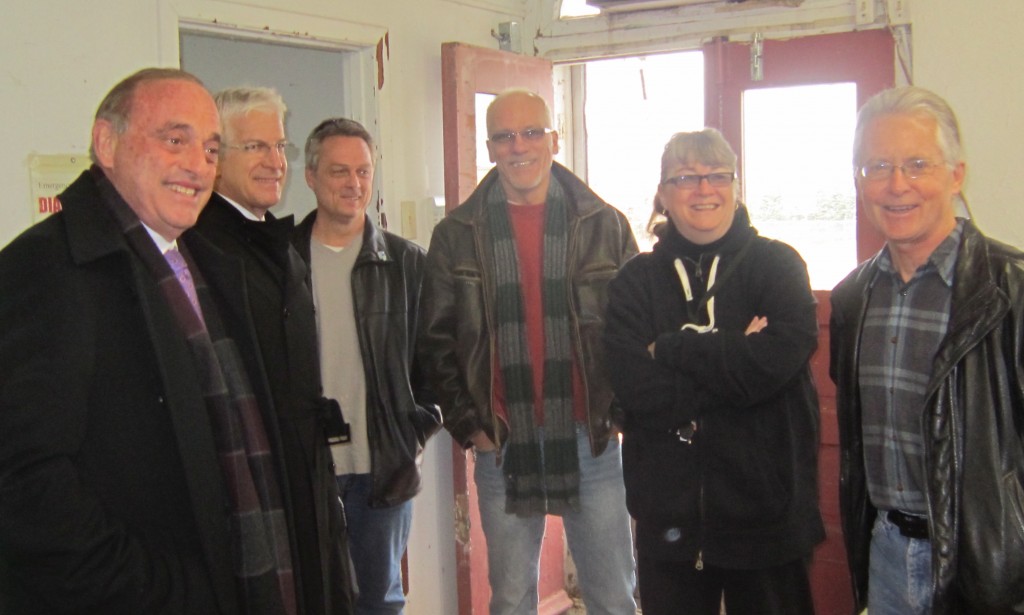 Without the leadership needed – this crew could go nowhere – the city lost the energy, knowledge and passion of some fine people. The city had reached its limit – they knew nothing was going to happen with this committee. It was sucking up all kinds of resources, holding meetings that achieved nothing and totally disillusioning its members. The frustration expressed by the members of the committee was painful to listen to – but as a group they weren’t able to summon the personal courage or the courage of their convictions to remove Nicholas Leblovic as chair.
They were not only afraid to remove him as chair – they actually re-elected him as chair at a time when there wasn’t a natural leader available.
But then Bob Wingfield was appointed to the committee and that was the opportunity for the members to take a brave, bold move and give the important committee the life and leadership it needed.
How? Here’s how.
A member raises his hand at a meeting and declares he has a motion he wishes to put forward. The chair has to recognize the member.
The motion is: To declare the chair of the Waterfront Access and Protection Advisory Committee vacant.
There will be a look of stunned disbelief on the face of the chair.
Within seconds another member raises his hand and says: “I second the motion”.
Seconds after that a third member asks the chair to call the vote.
And they vote on the motion (the vast majority would vote to remove this chair) and the chair is then vacant and the members can proceed to elect a new chair and get on with the business they were asked to do on behalf of the city.
Messy – sure it is – but not nearly as messy as this really important committee with some intelligent, dedicated Burlingtonians on it who were and are passionate about what we do with our waterfront.
That opportunity is basically lost – unless, at the Advisory committees next meeting, which was scheduled for Friday, the 13th, the committee does something along these lines and then appears at the city council meeting on the 16th and asks the council to defer the vote to sunset the committee on December 31st, 2012 and allow them to come back with an agenda and a work plan that sets out how they will get some much needed work done.
Will the members of the Advisory committee do this and save an important committee – they can’t – the meeting planned for July 13 was cancelled – they will not meet again until September.

 By Pepper Parr By Pepper Parr
BURLINGTON, ON July 10, 2012 It could have been different, for the sake of Burlington it should have been different, but when the Budget and Corporate Services committee report on Tuesday set out the recommendation that the Waterfront Access and Protection Advisory committee be sunset December 31, 2012, the city lost eyes, opinions and advice that is badly needed.
The problem was that the Advisory committee didn’t give very much in the way of advice or direction but instead got stuck in endless meetings during which they were briefed by expert after expert. It was a little like a university course, interesting and instructive but not the purpose or mandate of the committee.
There are some fine people on that committee – they were just poorly led.
The recommendation to the Council committee was brief and brutal – one thirteen word sentence. Kill it, and other than Councillor Marianne Meed Ward, no one really came to its defense.
Chair Nicholas Leblovic spoke to the Council committee and said he felt he had been “blind-sided” by the recommendation, which is a bit of a stretch. He had been told numerous times by people who knew this committee was in trouble. As chair he didn’t have the capacity to lead nor did he appear to have the capacity to listen.
Despite the chair, the committee did some very good work and some of that work does need follow up. The Windows on the Lake problem has to be resolved and without a committee to press the matter – not much will get done. Rob Peachy, Manager of Parks and Open Spaces for the city told the committee that “this was not one of their favourite files”. Having to go up against influential landowners along the Lakeshore who don’t want people wandering about close to their property is not an easy task.
At one point the city gave a resident a lease on a strip of land leading to the edge of the lake for 50 years at $2 a year. That is called a deal.
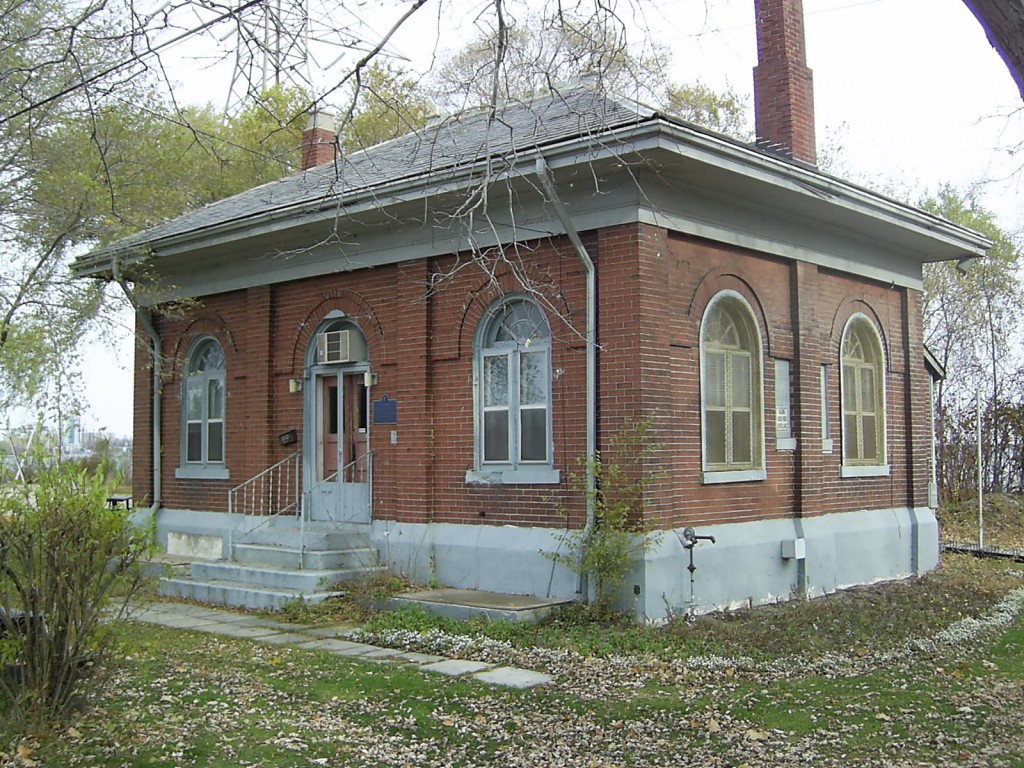 One of the ideas the Waterfront Advisory people had that actually got out of the committee and to Council was to turn the Pump House into a coffee shop. Councillor Dennison wouldn’t hear of it – he wanted an upscale wine bar where he could watch the sun set. He did vote to sunset the committee. The committee managed to get a resolution through that asked the city to look into making the Pump House more than an empty storage space and look for ways to turn it into an upscale coffee shop. When the recommendation got to Council Committee, Councillor Jack Dennison would have none of that – he wanted a place where he could sit on a deck with a glass of wine in his hand and enjoy the setting sun.
Council was eager for advice, directions and ideas from this committee – there were just so few, and not because the members had nothing to say – they just couldn’t get much past the hands of the chair who seemed unable to let his members do what they were very capable of doing.
Leblovic did pull of one significant event and that was getting former Toronto ,Mayor David Crombie to speak to the committee. Crombie was energetic and had all kinds of ideas for the committee. Crombie urged them to be proactive and to hold a design competition that would bring forward ideas and get something happening. But that was about as far as it got – except for the work that Gary Scobie and Sarah Banks did with that idea.
A city council committee kind of liked the idea when Scobie took it to them. They didn’t buy his first cut of an idea – and asked him to work on it more and bring it back. Unfortunately, Sarah Banks, the intellectual and emotionally driven leader behind the idea moved from Burlington, a city she was never particularly comfortable in.
Banks didn’t have the best of working relationships with Leblovic and really didn’t get the support she needed. She was one of those people who just wanted to get things done and not just spin her wheels.
City General Manager Community Services, Scott Stewart, spent far too many hours at the committee table gnashing his teeth and told council committee that he voted with his feet and just stopped attending the meetings.
In her passionate plea to not sunset the Waterfront committee Councillor Meed Ward pointed out that there were some structural problems with the committee but they could be fixed. The demands on city hall staff could be reduced. She made no comment about the leadership of the committee.
This was a Committee that had three Council members on it; the Mayor, who attended frequently along with Councillors Meed Ward and Craven. There is no other Advisory committee in the city that has as much Council representation.
Where does the city go now for advice on the waterfront ? The Mayor thinks he might just `grab a bunch of people and look to them for input” – so much for city wide representation.
The city report suggested there was considerable overlap between the Waterfront Advisory and the several other Advisory committees in place; they didn’t think that when the committee was created.
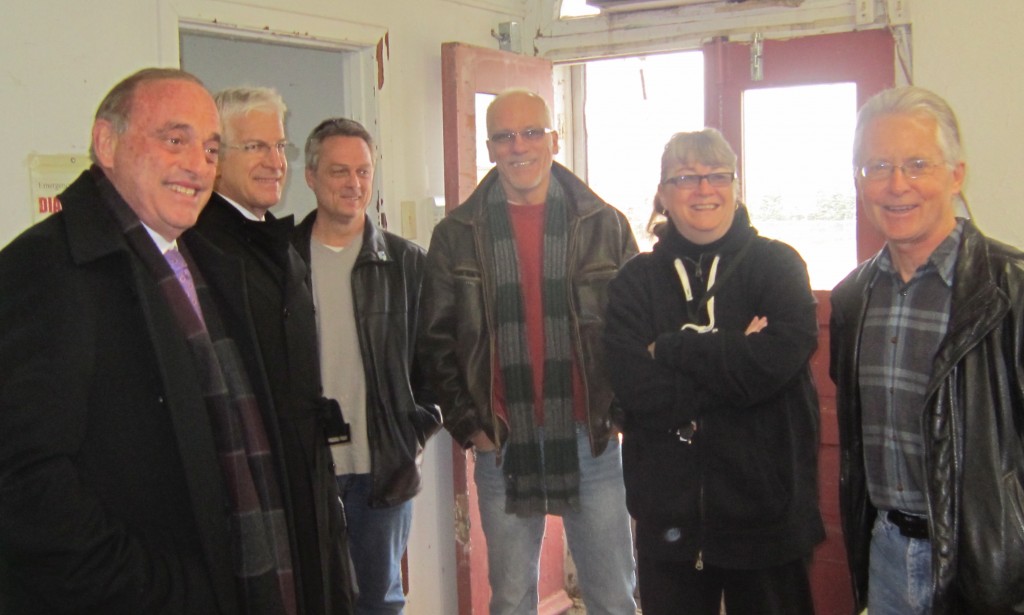 Members of the Waterfront Advisory Committee tour the Pump House on the Beachway. One of the really solid recommendation that made it out of the committee to city council was to turn the Pump House into a coffee shop – wine bar. The Committee won’t exist to see that happen. Nicholas Leblovic is on the left. Waterfront Advisory was created by former Mayor Cam Jackson, who at the time saw the issue of the pier and the whole waterfront mess as having the potential to substantially impact his re-election campaign. The Committee was set up to counter some of the clout that Save Our Waterfront (SOW) was having. They had 2000 members across the city, they were active and they were focused And they had some money in the bank. The committee served as part of Marianne Meed Ward’s election apparatus. It was never official, but there was little doubt in the minds of many that SOW and Meed Ward were joined at the hip.
And there was very little doubt that Nicholas Leblovic and Mayor Jackson were joined at the hip as well when Leblovic was appointed to the committee and quickly became its chair.
The Pier turned out not to be quite the issue many thought it would be during the municipal election and it turned out not to appear on the Waterfront Advisory Committee agenda as well.
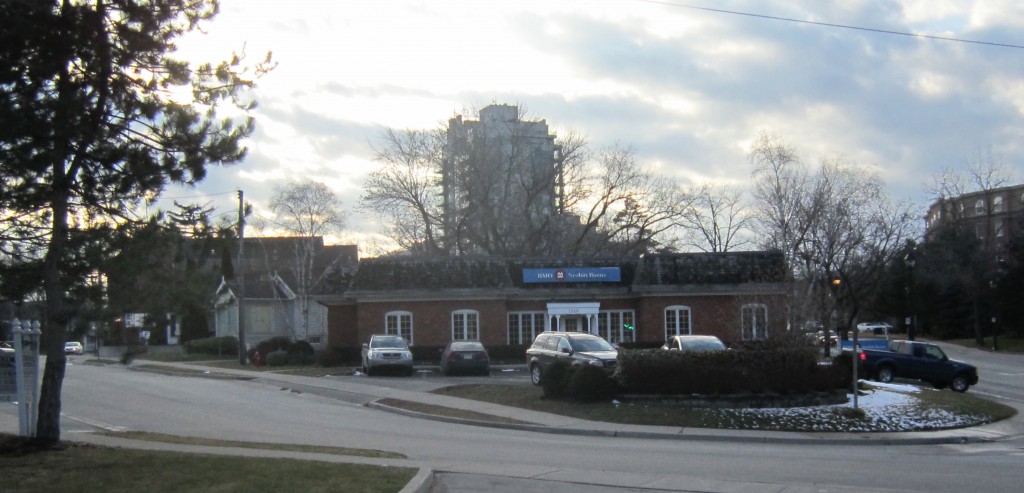 It was called the “football” because of its shape. This view, from the east end looking west, is land privately owned. There are more than a dozen property owners in the “football” with none of the land owned by the city. Getting the property owners to work together to develop a waterfront that will compliment Spencer Smith Park and lessen the massive impact the eventual 22 story tower to be built to the immediate west of the football requires the kind of leadership the city has yet to see. The Waterfront Advisory did some excellent research but wasn’t able to land the idea – or the opportunity. What was called the Waterfront Precinct drew most of the time and attention of the committee. They believed that citizens should have some say in what happens to private lands in such a sensitive part of the city but try as they did – they were never able to get any traction with the major players. They did do a lot of solid ground work and they helped the city fully understand who the players were in the game on what came to be called – the football, that oblong piece of land between Old Lakeshore Road, Lakeshore Road from Pearl on the west to where the two Lakeshores merge on the west. But they were not able to create any consensus on what was really a political issue.
There had to be some major “bully pulpit” leadership from city hall that would leverage what the Waterfront Advisory people were doing and what was coming from city hall – that didn’t happen. Mayor Goldring never really had much in the way of a working relationship with Leblovic who probably saw him as a Cam Jackson holdout.
David Crombie had the right idea – he just wasn’t able to effectively infect Mayor Goldring with the kind of grit it takes to lead this kind of community building.
The Waterfront Advisory should have had a major impact on the input side of the Official Plan Review. People in the Planning department, and elsewhere in city hall, realized the Advisory committee was never going to get anything done and various people on the Waterfront committee managed to slickly slide the issue out of Waterfront over to Official Plan Review. The report that recommended sun setting the committee put it rather well when it said: With the issue of the Old Lakeshore Road re-development now being addressed through the Official Plan process, the current work plan of the committee is substantially complete.”
They took Leblovic’s lunch off his plate while he had his knife and fork in his hand – he missed that play completely.
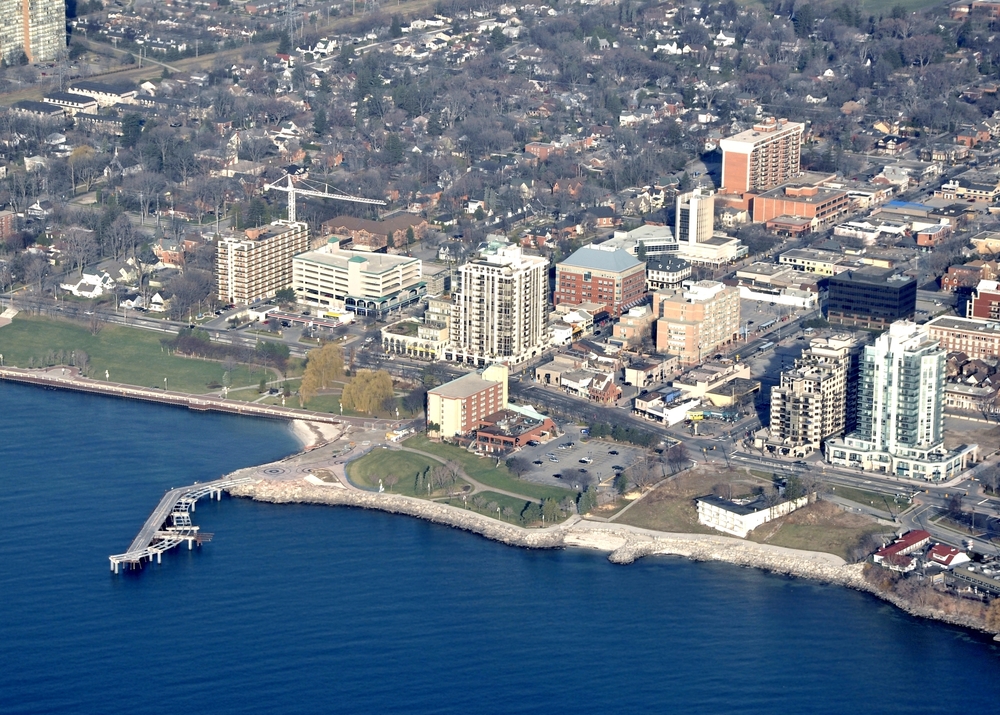 West of the Pier, the waterfront is nicely developed and if we do it right the Beachway should make the lake frontage from the park to the canal a great place to be. The task, that the Waterfront Advisory wasn’t able to do is come up with advice the city could use to develop east of the pier. That is still a challenge waiting for some leadership. What now for the Waterfront? Does SOW have to come back to life and lead that agenda. That wouldn’t be a bad idea. During the Council committee meeting it was suggested that perhaps BurlingtonGreen could take on the task or perhaps the Sustainability Advisory people; the Mayor has an excellent working relationship with that group.
Right now however, one of the two most vital elements in the city’s identity are either adrift or under threat. The continued chatter at the provincial level about a road through Mt. Nemo and the Niagara Escarpment and no real community led leadership on waterfront development, our anchors are laying underneath the water unattached to any chains.
This is not a healthy place to be.

 By Pepper Parr By Pepper Parr
BURLINGTON, ON July 11, 2012 The first harvest is ready!!! The jars have been readied, the tags are printed and the product is now on sale. There will be between 60 and 70 lbs. available. It will be on sale at the new farmer’s market held every Friday from 11 – 2 on John Street just north of James Street back in behind Centro Gardens.
Of course there is more than just natural honey on sale but let’s let Russell Gibbs tell the story about the honey; it’s quite a tale.
 Russell Gibbs – a beekeeper and a graphic designer – with a sweet tooth. “This harvest is the first bloom of the 2012 season, our bees forage on a variety of plants and this early summer harvest is full-bodied and rich – some of the best honey I’ve had in a while if I do say so myself. It’s a true Southern Ontario wildflower honey. It’s also packaged quite beautifully
 The real thing – from the hive to you in a re-usable Mason jar. Honey is available now through the beekeeper (me) for $10 per 500 g jar. We have 60 jars and this will be available until it’s sold out. There will also be a late summer harvest which will be available in September 2012.
A couple of notes about our honey;
– Our honey is as “straight from the hive” as it gets. We extract the frames, filter, then bottle it.
– All real honey will crystallize over time, if that happens just place the jar in warm water (without the lid) until it softens up – don’t boil or put it in the microwave.
– Our honey is more expensive than others, why? For starters its not mass produced. We’re a small batch/small operation and not only are we focused on the quality of the product we also believe in quality packaging.”
 Russell Gibbs comes from a long line of bee keepers. The family “beeyard” around 1950. Gibbs Honey has been around since the 40′s, maybe even before the 40′s? in various iterations and incarnations. The first beekeeper in my family was my great grandfather Albert Gibbs. He kept a couple of colonies on the farm, which is what most farmers did back then. When my grandfather Michael took over the farm he decided to expand the operation and sell honey. He kept close to 100 hives, that number went up and down throughout his career as a hobbyist beekeeper. My uncles eventually took it over from him and grew it into a commercial operation, they own and operate Gibbs Honey in Dalkeith, Ontario on the family farm. My cousin Jason is researching Sweat bees with Cornell University, last year he discovered 19 new species.
Gibbs Honey in Dundas, Ontario is operated by Russell Gibbs, a 4th generation beekeeper and graphic designer. Russell got into beekeeping, while searching for a deeper connection to his family history and nature. It all started when his Dad gave him his old beekeeping veil and a copy of “The Hive and the Honey Bee” by L.L. Langstroth. After reading lots of other books, taking courses and finding a beekeeping mentor he decided to go out on his own. Russell kept two hives in 2011 and is expanding to 8 for the 2012 season.

 By Pepper Parr By Pepper Parr
BURLINGTON, ON July 9, 2012 The City of Burlington has announced that Joan Ford, long-time city employee and acting executive director of the finance department, has been named director of finance effective July 9.
Ford’s home position was deputy treasurer with the city. She has served as acting executive director of finance since July 2010, after one year as acting director of finance from April 2009 to April 2010.
“Joan has been doing an excellent job in the acting role as head of the finance department,” said Kim Phillips, general manager of corporate services. “I look forward to continuing to work with Joan as she continues to lead a top-notch finance team at the city.”
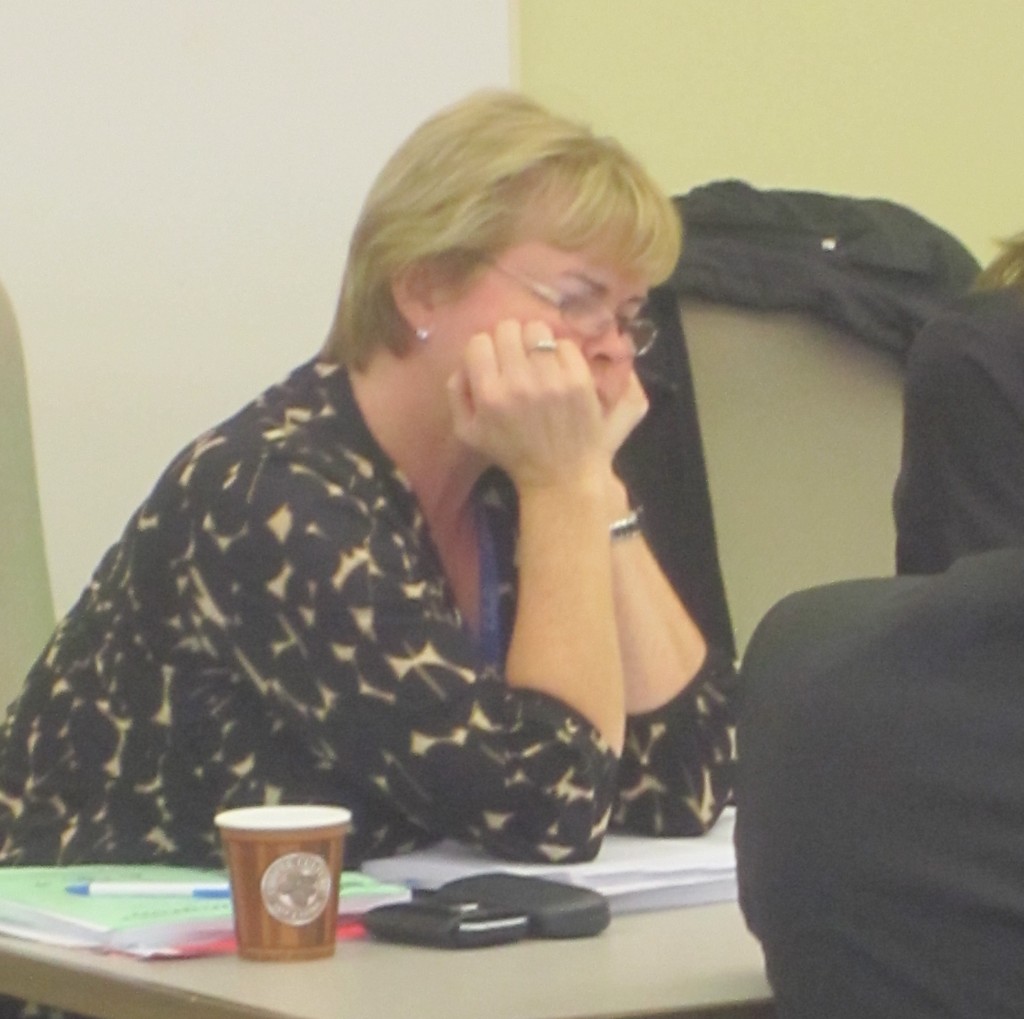 Joan Ford, Director of Finance – Finally! Ford, who has been with the city since 1988, has an Honours BA in Economics from the University of Waterloo and is completing her CMA designation through the CMA Executive Program with the Certified Management Accountants of Ontario. She has progressed through a number of finance roles at the City of Burlington, including:
Financial analyst
Senior financial analyst
Supervisor of financial policy
Manager of revenue and taxation
Manager of financial planning and taxation
Deputy Treasurer
“I am pleased to continue in this leadership role,” Ford said. “Finance has a skilled and professional staff team in place that is committed to serving the needs of City Council and the people of Burlington.”
The city recently restructured its three divisions to balance workload, develop synergies within divisions and increase corporate capacity to best reflect the needs of the community. Kim Phillips and Scott Stewart are two of the three general managers. Recruitment for a third general manager will take place this fall.
Now that you’ve read all the bafflegab – know that Joan Ford did all the hard work that had to be done to get where she is. Getting her Certified Management Accountant (CMA) designation was not easy – she had a household to manage and a budget process that was at times close to a killer.
Ask her for a budget number – and zap – she had it at her fingertips. Look for a new innovative way to get data into the hands of department heads who had their own budgets to manage and at the same time put numbers in the hands of council members – and both Joan and her staff come up with good ideas.
While not only doing the job that we really didn’t pay her for doing – she developed one of the smartest departments in the city. Some of the people in her department have moved on to other departments where a tougher, more accountable approach to the numbers will begin to be felt.
Congratulations Joan – you earned this one.
Now take a well-earned vacation and have the CMA certificate framed and on your office wall.

 By Pepper Parr By Pepper Parr
BURLINGTON, ON July 9, 2012 Her name is Alice and she is close to being the “breadwinner”, along with a herd of goats, for Featherstone Family Farm on Guelph Line just past the heart of Lowville. Alice shares the 25+ acre property with a herd of goats, all kinds of foul – chickens, ducks – a whopper of a sow and piglets galore.
 Ruby – mother to dozens of piglets, lays in a cool spot away from the sucklings. That plus three children who scamper about with next to no clothing – they are of an age where you can do that. All is carefully watched over by Michelle Macdonald while her husband works the tractor mucking out the barn.
 Chris the boarder, with Alice and Daisy the dog. The two brown beef cows are being grass fed for fall. Chris, the boarder who lives in a trailer, rounds out the picture of the family at Featherstone Farm who are part of Halton’s rural community that includes not only the tony equestrian set but small market farmers who choose to live a different life style.
The first week of the Farmer’s Market, held every Friday between 11 and 2 in the John Street parking lot behind Centro Garden, went well. The offerings were small but the atmosphere and the family feeling was worth the effort and the time.
The farmer’s market is still working through it’s identity – it is a part of something known as Plan B, which is exactly what you would expect – the plan behind the first plan you had. Except these people are focused on healthy eating and getting produce from local farms onto local kitchen tables.
Lettuce from California doesn’t make a lot of sense to the Plan B people. Trucking food across a continent isn’t really sustainable from their point of view. Focusing on local and knowing a bit more about the people who provide your food is the direction they favour and anyone who sees the worlds the way the Plan B people do – might want to mosey along.
Barry Imber, a graphics designer by profession, has a thing about eating well and eating local produce, decided Burlington needed something downtown that was organic on its focus and he sort of made it happen. The first week went well; the second Friday was blisteringly hot and it too went well.
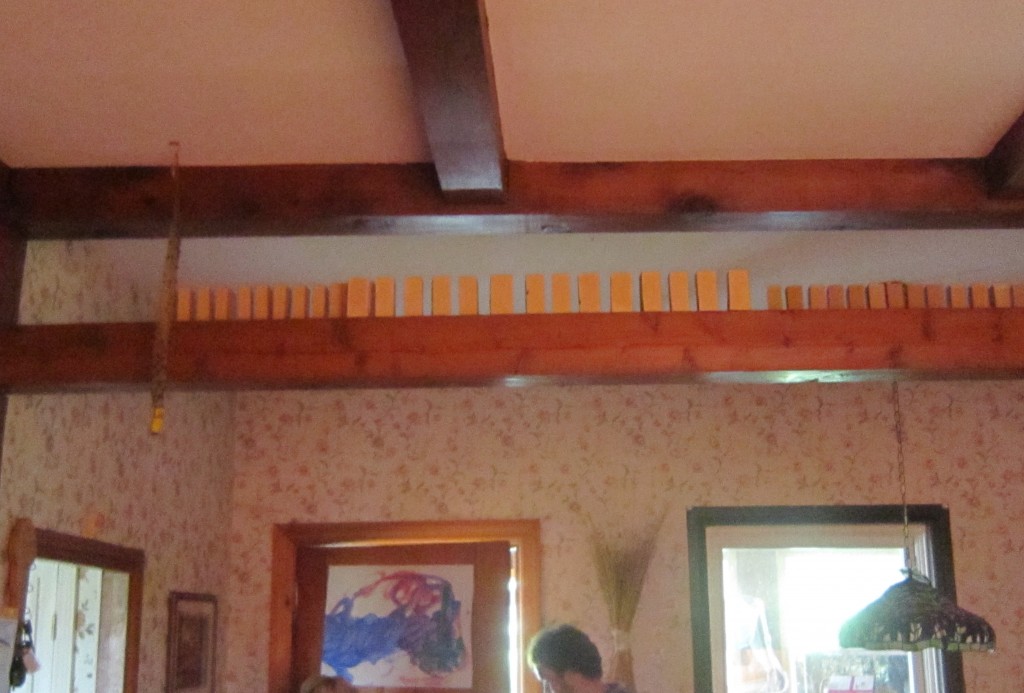 Soap being readied for sale sits on a beam in the kitchen – “best place to cure it” says Michelle Macdonald, farm operator The third Friday will see some additions to the offerings. Michelle Macdonald will be bringing some hand made soap that is now ready for sale. Made on her farm with pork lard, goat milk, lye and pure essential oils. Some with lavender sprinkled into the soap square. They are currently in her house sitting up on beams where it is getting ready for sale.
The Macdonald farm sells eggs from the farm gate – there is never enough to go around. They sell bacon and other pork products. They use the milk from their herd of goats for other products they produce. They are raising two beef cattle that will be ready for market later in the year.
The third week will see some growth in terms of the products offered and, if a Burlington resident chef who is well known and respected in the area for their passion for local natural foods and gastronomy, does not see the birth of a child they are expecting , they will be on site filling in the gaps with beef and game this week and eventually cheeses and other related products.
This chef – you have to be there Friday to learn who it is, will be drawing from his extensive list of natural food producers and farmer relationships will be doing some sample cooking and demonstrations from time to time.
Imber explains the situation thusly: “The tentative thing here is that he is about to have a baby any minute so there is a chance he just can’t make it. I’ve insisted that the market not be a thought in his mind if it’s at all challenging to juggle a new baby, husband responsibilities and frozen meat.” That “frozen meat” is a clue I think to whom the chef is.
In the event that the baby arrives –the chef will be at the market on the 20th.
Featherstone was one of the mainstays at the first session of Burlington’s Friday Market that is held on John Street right behind the lush Centro Garden.
The Burlington initiative may get some coverage in Pure Green Magazine from Huntsville. They will be joining the crowd at the market on the 20th.
So – the Plan B farmer’s market is taking on a life and style of its own. Imber is working on a bakery source to add to the offerings.

 By Pepper Parr By Pepper Parr
BURLINGTON, ON July 8, 2010 A city council committee will consider a contribution agreement confirming how and when the city will contribute $60 million toward the redevelopment of Joseph Brant Memorial Hospital, subject to the conditions within the agreement.
The city agreed in principle to put up half of the $120 million the province required the community to contribute to the redevelopment of a hospital built in 1961. The last major update and refurbishment was more than 40 years ago.
Problems cropped up when the hospital suggested the city pay for the building of the parking garage that was needed early in the redevelopment. Cars had to be given a place to park so that space could be used to dig a hole in the ground and begin the actual construction the hospital hopes to see started before the end of the year.
City council has possession of this file – which means reports and site plans go to a council committee where they get debated and discussed.. The usual practice for Council is to delegate this to the Director of Planning.
The City approved a contribution of up to $60 million in December 2009 , with the intention of preparing a contribution agreement between the city and the hospital. The go-forward strategy, approved by City Council in April 2012, called for the city to negotiate a contribution agreement that provides for the “responsible and timely release of funds.” Four negotiation meetings were held between the negotiating teams for the city and the hospital in May and June 2012.
These were very contentious meetings and while everyone has kissed and made up the city at the time insisted on knowing what was going to be done with the money they drew from taxpayers.
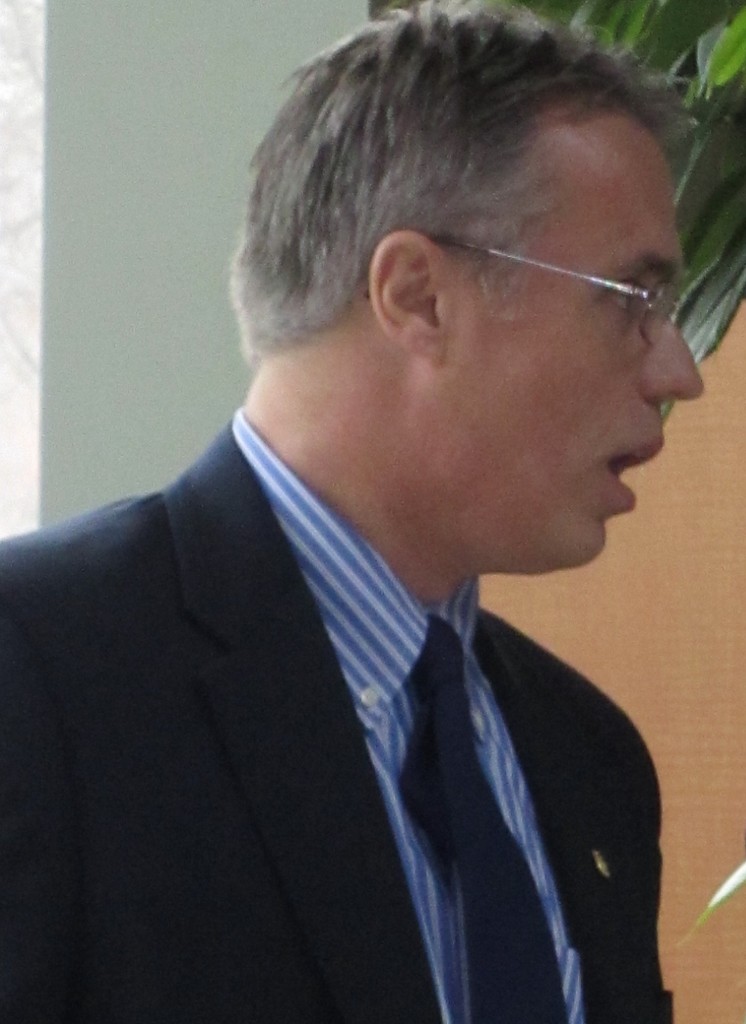 Mayor does the usual political speak and tells taxpayers the agreement with the hospital represents a milestone – he could have said it represents a “millstone” to the taxpayers and been just as correct. In typical political bafflegab Mayor Goldring said: “This agreement is an important milestone in the much-needed redevelopment of Joseph Brant Memorial Hospital. We want to ensure that we have the best agreement possible for taxpayers while ensuring high quality health care for years to come.”
Assuming the contribution agreement is approved by City Council on July 16, the city’s contribution will go toward the purchase of equipment for the second phase of the hospital’s redevelopment, which includes construction of about 288,000 square feet (21,182 square metres) of new hospital space, including a new six-storey south tower; construction of a new power plant; and the renovation of about 116,000 square feet (10,777 square metres) within the existing hospital building.
Construction of the hospital is planned to begin in December 2014 and will take about three years to complete. Before that construction can get underway the hospital has to clear some land and build a structure that will include a parking garage. This first phase is scheduled to begin in early 2013 and finish in early 2014. It will include construction of the parking garage and administrative space that will house the Halton McMaster Family Health Centre. City funds are not contributing to the first phase of the redevelopment.
In a prepared statement city general manager Scott Stewart, General Manager of Community Services said: “On behalf of the staff negotiating team, I am pleased to bring forward what we believe is a responsible draft contribution agreement for council to consider.” He might have added that there was a lot of arm twisting and muttering under their breath to get to this point. Stewart deserves credit for landing this one; the hospital administration did not make it easy.
 The construction of the additions to the hospital will orient everything towards the lake and result in significant changes to the traffic flow and to the way people see Lakeshore Road and the Beachway community. By the end of 2012, the city will have a total of $8.4 million in the bank collecting interest. A total of $4.8 million came from a special tax levy. City Council also earmarked $3.6 million from previous years’ surpluses in 2009 through 2011. The 2012 tax levy amounted to $7.49 for each $100,000 of residential assessment.
City Manager Jeff Fielding said at a council meeting that a $60 million undertaking will be the biggest Burlington has ever done and it represents a significant long term expense for the taxpayers.
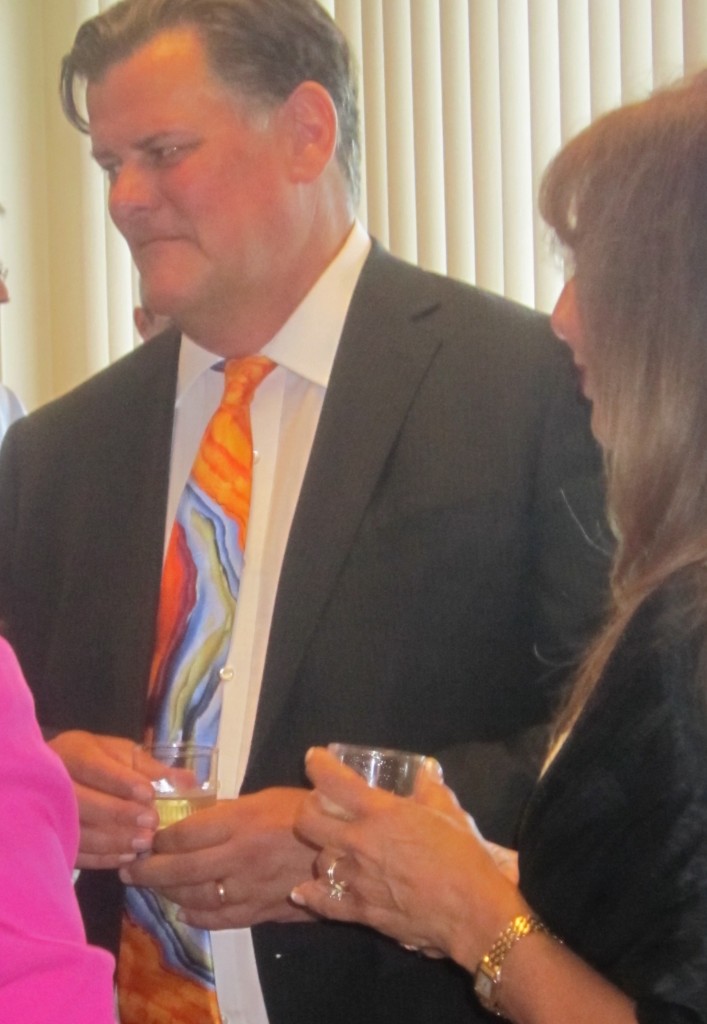 Stephen Friday, JBMH chair will bring a different style to the role he now plays. He has a strong working relationship with the Mayor which will help. He also has the smartest collection of ties in the city. Up until very recently hospitals were a provincial responsibility – that changed when the province looked to the municipalities for a portion of the funding where new, significant developments were being done. If the municipality is at the table financially one would hope it would have more input on the operation of the hospital – which would result on a significant change in the way the city and the hospital administration work together.
There is now a new chair at the hospital. Susan Busby who spent more than 15 years with first the hospital foundation and then the hospital board took a well-earned retirement. She has been replaced by Stephen Friday who brings a significantly different operating style to what he does and has a background that included working with very senior managers and was a major force in one of the larger asset management firms in Ontario.
There are opportunities now for both the Mayor of the city and Stephen Friday, the new hospital chair to fashion a different working relationship that will reflect the changing times.

 By Pepper Parr By Pepper Parr
BURLINGTON, ON July 5, 2012 For Gary Carr, chair of the Region of Halton the real problem seemed to be that when a Minister of the provincial government gets shuffled off to another department – they take all the promises they made with them. It just isn’t the way a government can be run according to Carr, who has been in the government game for a long time. He served as an MPP from 1990 to 2003 and Speaker of the Legislature from 1999 to 2003. He’s been there and he has seen it all and right now – he doesn’t like what he is seeing.
The concern is Burlington’s Escarpment which is the rural part of the city. The province has a growth policy which if met is going to require new roads to handle all the increased traffic.
The bureaucrats get told to do a study, which in this case is a full, detailed Environmental Assessment – which means they look at everything. The bureaucrats don’t create policy – they just do the research and come forward with recommendations. What is scaring the daylights out of Burlington is that those recommendations tend to become the only choice and Burlington has learned, from painful past experience, to get your two cents worth in while the thinking is being done.
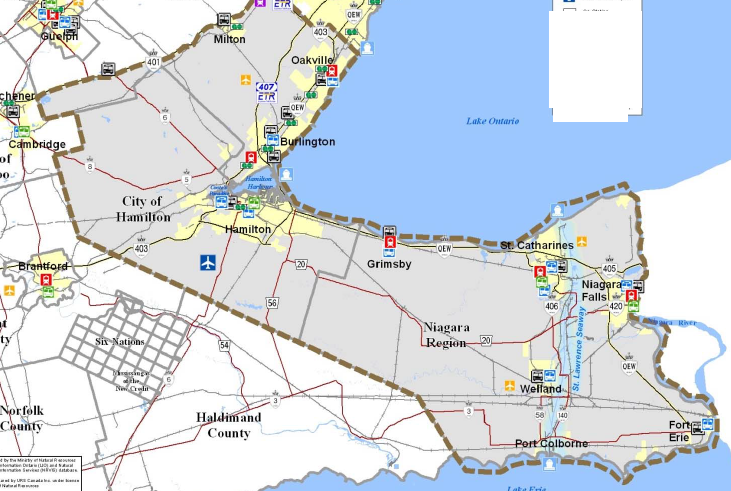 This is the part of the province provincial bureaucrats are studying as they look for ways to create more capacity for road traffic. Their studies indicate that one of the ways to meet the demand for additional road capacity is to run a corridor through the Escarpment. Other groups feel this isn’t necessary and the Regional government thinks it is totally wrong. Chairman Carr had some difficulty understanding how very significant decisions made at the Regional level, communicated to the government and be known to the bureaucrats doing the research, but have no impact on that research – other than be “documented”. Carr was close to aghast when he learned that the bureaucrats knew about the Region’s concerns which did not result in any comments to the study team from the Ministry. “Did it not occur to you to ask questions?”
 The Region and the city of Burlington are focused on the west area. And they don’t like the look of some of the plans that are being talked about. The Regional people apparently don’t believe that the documented concerns were to have all that much impact. Carr believes that the 22-0 regional council vote against any road through the Escarpment – a shut out as Carr put it – has to have an impact and not just be “documented”.
Mayor Goldring wanted to know if there was a matrix used to arrive at a decision. There was: it involved transportation performance, the environment, the economy and communities. Behind those four main points were a host of factors that impacted the recommendation the bureaucrats would make.
The nagging suspicion at the Region was that the EA recommendation would become a decision and Burlington would have a new road north of the current Dundas/Hwy 407 which would then be the new build to line – and with that, what the city has as a rural element would be gone.
 The bureaucrats have developed a building block approach and are looking at all the existing options. Group ! is made up of places where they think they can optimize the existing capacity. If that doesn’t provide what they feel is needed to move up to Group 2 and consider new expanded NON road infrastructure. If they can’t get the capacity they maintain they need the they move into groups 3 and 4 where they look at widening and improving existing roads and look at new transportation corridor. All the bureaucrats do, explained John Slobodzian, is collect information and, as he put it “we document”. The inference was that with all the documentation they are able to make recommendations that get passed along to the Ministry. Fine – but is there anyone within the Ministry who would know the file well enough to seriously review and weigh the recommendations made?
It’s sort of like a trial – where there is no defense offered nor is there an opportunity to put forward a defense. The prosecution, in this case a group of well-intentioned bureaucrats who have no skin in the game, collect evidence and then make a case.
The Region is going to have to change the way this “trial” is going and introduce some rules that allow them to make their counter case. It would be unwise to expect the Ministry to invite the Region in and ask them to argue against the recommendations.
Chair Carr said this was a political decision – which it is. And while the province is the senior level of government – the Region can, should, and will have to inject a different approach to how the decision is reached – or the Escarpment will get rolled over – just the way the Red Hill Expressway in Hamilton came into being.
The regional planning and public works meeting at which the latest maps were presented put the group at a distinct disadvantage. All they had to look at was small 8.5 x 11 sheets of paper that did not show the level of detail needed to fully understand what was being proposed.
The bureaucrats advised that the maps were on the web site, which is a little on the shabby side in terms of sharing information. The study team had an obligation to provide the best possible images and have them up on the wall in extra large format where they could be viewed and studied before there was a question and answer session. The regional people really didn’t know what they were looking at and couldn’t make much of an assessment. Perhaps that is the way the bureaucrats wanted it.?
Burlington and the other municipalities that make up the Region have learned to make a lot of noise early in the game and ensure that everything they say and do is “documented” – but that may not be enough.
Chair Carr, Mayor Goldring and Councillor Taylor are finding that large public meetings with 800 + people in the room while impressive, doesn’t seem to sway the people at Queen’s Park.
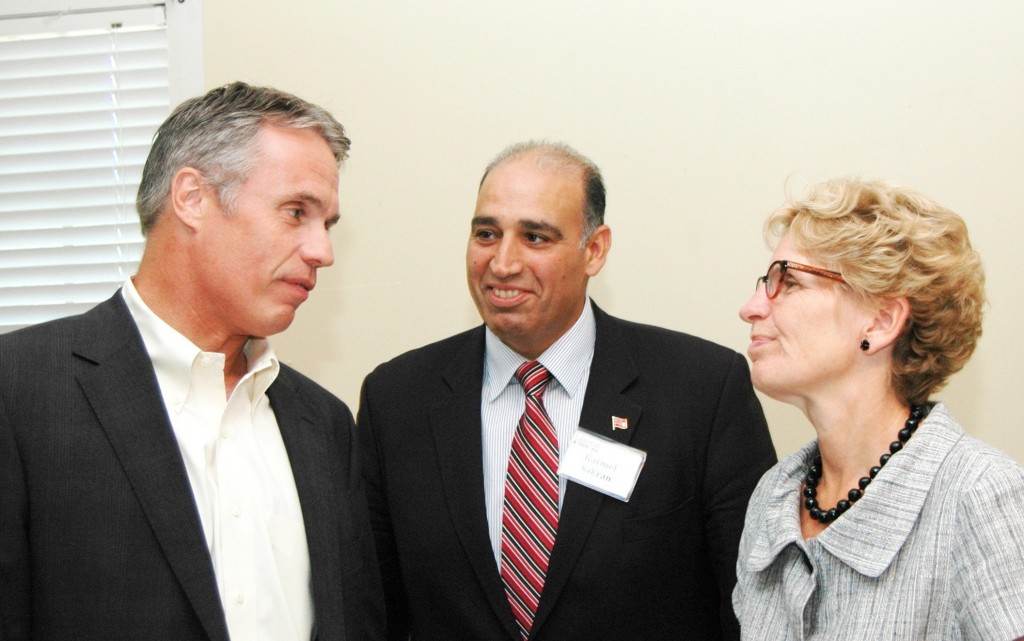 Do you get the sense that Mayor Goldring on the left believes a word Minister Wynne on the right is saying? She was delivering an election promise. They find they get a rock solid promise from the Minister of Transportation during an election, who at that time was Kathleen Wynne. After the election Wynne gets shuffled off to Municipal Affairs and takes her promise not to have a highway cut through the Escarpment with her.
All these comments came out at a presentation made by the Ministry of Transportation Environmental Assessment Project Team that was telling a Regional Planning and Public Works Committee where they were with their Niagara to GTA Environmental Assessment study.
The presentation began with the statement from the leader of the Ministry project team that the status quo was not an option, certainly set the stage. John Slobodzian, project manager for the Environmental study said “there will be more than 1.2 million additional passenger and commercial vehicle trips per day in the NGTA study area by 2031. He added that “transit is an important part of the solution, and it is assumed that plans and investment in transit over the next 20 years will result in an additional 700 million transit trips being accommodated in the GTHA by 2031. However, he added, we cannot assume that those coming to the region will travel exclusively by bus or rail.
New highway capacity was going to be required. The study team was conducting more in-depth explorations of highway expansion options
With that many trips in the offing the Ministry of Transportation people believe a new highway is going to be needed. “Those involved in moving goods agree that while there is a role for every mode, transport by truck is and will remain dominant.” New highway capacity is required and the Escarpment route is seen as one of the possibilities.
The Region was told shortly after the last election that there would be “one window” for them to work through with the provincial government and that would be Municipal Affairs which was fine by the Region – they always felt they were getting the run around from Ministry to Ministry. The politician that made a promise as Minister of Transport got shuffled over to the Ministry of Municipal Affairs – which is supposed to be the Ministry the Region is to deal with. Not a lot of trust between these players.
Add to that was the concern that with Municipal Affairs saying one thing, there would be no road through the Escarpment, the people over at Transportation were still beavering away at the Environmental Assessment that had “more highways” written all over it and the Escarpment looking like it was a really good place to ram a road through.
Lurking behind all this is the fear that if a new highway is built it will just attract more traffic and that doesn’t sit all that well with Burlington..
The NGTA Environmental Assessment study team has spent just over $6 million to date on this project. The options they put forward have continued to shift – whether this is the result of concerns voiced by the Region is doubtful for John Slobodzian says that he is aware of the comments the Region has made as well as stories in the media. He adds that there is a lot of mis-understanding out there but Slobodzian has yet to invite the media in for an in-depth background session.
His position is that he is conducting a full scale Environmental Assessment and that to be true to the process, nothing gets taken off the table until all the data has been collected and all the evidence is in. With the data in hand – the study team then takes their findings to the public for comment..
What does this more in-depth exploration of highway expansion options” consist of? John Slobodzian says they will be:
Assessing the relative merits of widening key highways such as Highway 403 and the QEW to determine if this option is preferable to constructing a new highway corridor
Considering a wide range of criteria and factor areas — from transportation performance, to natural and cultural environments. The innovative ‘building block’ approach looked first at how best to use existing transportation facilities and expand transit/non-roadway infrastructure
The draft Strategy is based on full implementation of the Regional Transportation Plan (RTP) by Metrolinx and GO 2020 Strategic Plan. All the funding for that RTP is not in place yet and, as Councillor Dennison pointed out, with the province facing a $16 billion deficit, and the Metrolinx plans estimated to come in at about $55 billion – there is clearly a challenge to be met.
The funding is going to be someone else’s problem. John Slobodzian has to complete an Environmental Assessment and he wants to be true to that process.
He speaks of:
Adjustable speed limits (speed harmonization)
Transit use of highway shoulders to bypass congestion
Reversible (contra-flow) lanes and moveable barriers
Initiatives that support freight rail
Optimization and non-roadway improvements are a core part of the Strategy, but the focus of the additional analysis will be on the roadway elements.
An ongoing concern is with any recommendation to construct a new corridor connecting Highway 403 to the 407 ETR.
Assessment of the alternatives has been undertaken at too broad of a level, without adequate quantification of the impacts. The primary objective at this stage is more focused analysis based on more refined corridors to identify and assess more specific impacts
Getting that done will generally involve:
Identifying new corridor alternatives connecting to Highway 401, 407 ETR, and other highways such as Highway 6.
Development of a conceptual plan for widening existing highways
Identification of a preferred new corridor alternative and a preferred widening alternative, followed by evaluation to identify the preferred alternative overall
The overall preferred alternative, will form the basis for Phase 2. There will be individual EA if the preferred alternative is a new corridor. There will be a Class EA if the preferred alternative involves widening of existing highways. A class EA is less intensive than a full scale EA.
Are you still with me? The average tax payer will have a difficult time following and understanding all this.
There are some very serious questions to be asked about any recommendation to widen the QEW over a new corridor. John Slobodzian will review the impact of an 8 lane cross section – 6 general purpose and two HOV – and ask how far beyond 2031 would such a cross section provide adequate capacity?
A Stage two look at the QEW options would look at a 10 lane cross section.
As one reads all these ideas and possible options you wonder if we are just going to pave it all so that cars and trucks can move from one place to another.
At some point some really basic questions have to be asked. Have we got this right or are we heading down a path that leads to a place we do not want to go? A question being asked is: perhaps a planning horizon of 2031 is not long enough?
 All those grey wavy lines are corridors; places the EA study team think a new road could be built within. While the corridor markings are very wide the study team points out that any road would only be 170 metres wide. ONLY? Each of the options shows increased traffic coming into the area. W1 would be a corridor running up what is nowHwy 6. W2 and W3 take a more easterly approach. W4 is considerably south of the original road that would run through Burlington’s Escarpment. Some are suggesting future freight forecasts are understated. Some suggest getting trucks off the road all together and use rail or five some thought to loading trucks on barges and float them along the edge of Lake Ontario into the GTA.. We didn’t hear any out of the box, blue sky thinking being done. It seemed to be the just pave over fields and drive along new roads.
Every planner in the world knows that if you build a road – cars and trucks will find it and use. Stop building roads and people begin to look for other alternatives.
Environmental assessment studies are what bureaucrats do – they research and set out the options. The Region and particularly Burlington would like to feel that their views are being heard and that there was some real dialogue between the bureaucrats and the citizens.
While we all enjoy the summer the bureaucrats will draw lines on maps and put together documents and present it to us in the fall at one of those Public Information events. In the past these were not all that well attended, partially because they were held during the day.
The bureaucrats can expect a better community response this fall – we’ve learned a lesson.
Once the public consultation is complete the MTO people hope to put forward their final strategy late in 2012 or early 2013. The time line the study team is working on shows construction as something that is eight years away.
Let us make sure we play an active, robust role in the determination of the recommendations that go to the Ministry. The Region needs to work at getting stronger ties to the people that make the decisions at Queen’s Park. As chair Gary Carr put it – this is a political decision.
 Regional Chair Gary Carr told the provincial bureaucrats that the 22-0 vote against any new road being pushed through the Escarpment was basically a shut out. And Carr knows what a shut out means – he might have to lace up again to win this one. You want to hope that he does, The bureaucrats are correct in the need to complete the environmental assessment and not to take anything off the table until they have completed their work; to do so would be against all the rules used to do a full environmental assessment. The Region can probably live with that – what they can’t live with is the constant change in messaging and maps that come out with new corridors that were not seen before.
The most recent set of maps had one possible corridor shifting south of Dundas in Burlington, between Brant and Walkers Line. When Councillor Taylor pointed that out the response from the bureaucrats was – “that’s not supposed to be there – we will have to fix that”, comments like those don’t instill confidence.
John Slobodzian was given a rough ride. He will undoubtedly put his report together, discuss it with his superiors up the food chain. Chair Carr suggested he go one better and have his “political masters” watch the web cast.
If you’d like to watch the web cast – it’s available at www.halton.ca

|
|




























































































